Layering
Layering and mixing materials is another way of creating visual texture. There is no formula or rule as to how many materials to use or in what proportion they can be effectively mixed; this is where artistry comes in. Layering doesn’t need to be only in material mixes; there are endless ways to create more layering. Even floor plans can be layered by varying the axial relationships, creating unexpected dynamics.
Style
The basic design categories of traditional, modern, and transitional styles are all still strong, and none are considered passé. The infusion of a modern sensibility in much of today’s design has increased, mostly replacing decoration. Done effectively, this creates designs that are fresh and honest. Originality, personalization, and creativity can make each of these styles special in their execution. Like fashion today, the rules are meant to be broken.
THESE TRENDS ARE CLASSICS
In my design career, I’ve seen many periods of changing trends. In my mind, the present time is the most exciting and the most sophisticated—the bar just keeps rising higher. Technology and unprecedented communication give access to new ideas, materials, and products. This is one of the reasons why kitchen design is stronger and more creative than ever before. Almost all of these trends are not new, yet all are current and have proven themselves. The only change is in the translation of each, which keeps evolving. For that reason, they are not only trends but classics.

Here are some of my favorites:
Texture
Materials with texture give a sense of comfort and livability— two of the most important words in design today. Examples in kitchens can be any material within the space, including wood, stone, metal, or glass, in brushed, honed, and polished finishes, and used solo or combined. Hand-crafted finish processes, like sculpting, hammering, or scraping, are techniques that can change the nature of a material, making it softer and more inviting.
By Mick De Giulio
Mixing materials, such as metal and wood, adds texture and interest to kitchen design.

8 THE LIVING KITCHEN | ISSUE 1
EXPERT Advice
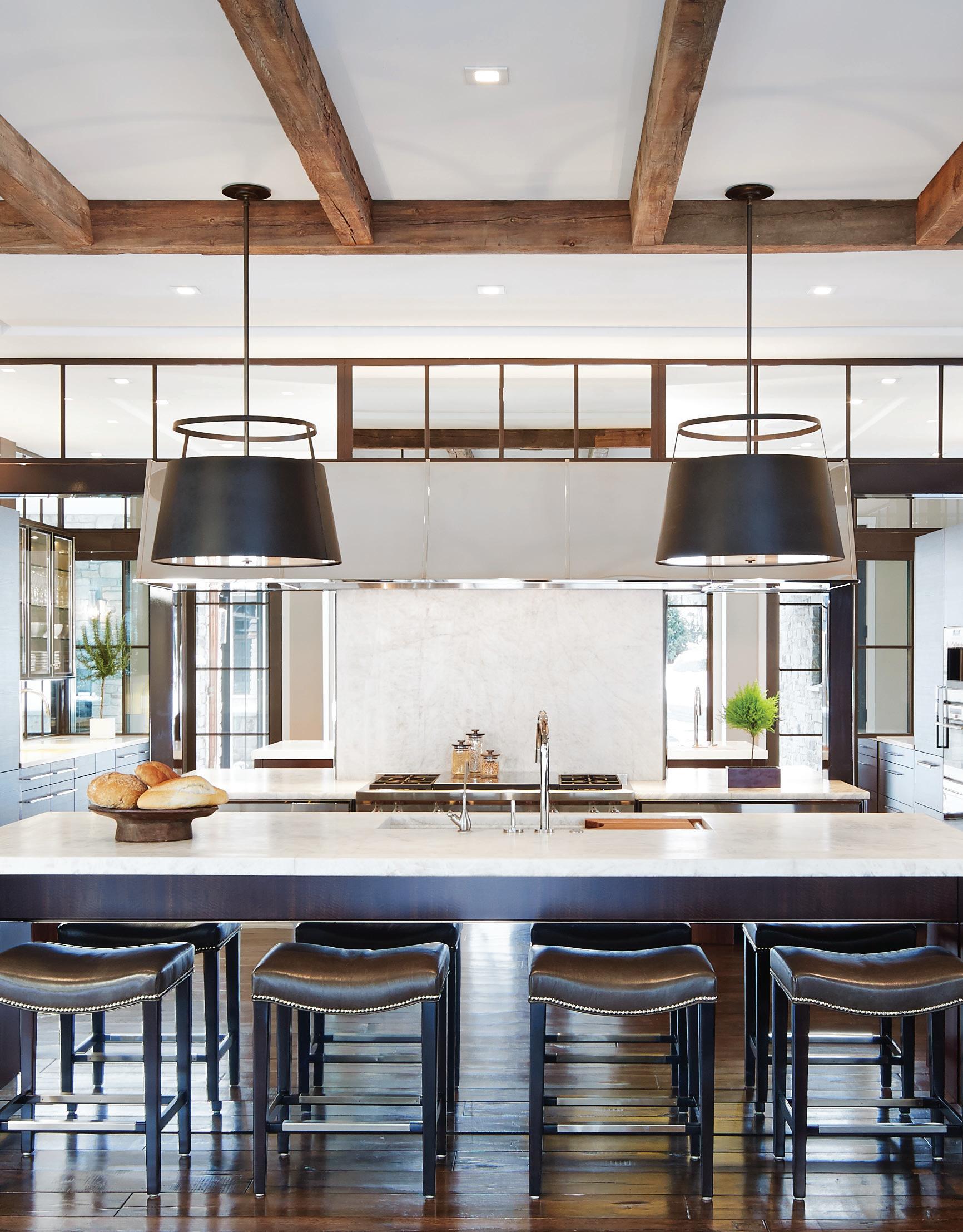
Open Kitchen Plans
As lifestyles continue to become more informal and many people have experienced open kitchen plans, this concept is growing and continues to strongly influence the way residences are being designed. The result is more connection and flow. I believe this idea has a long life ahead.

Larger Kitchens/Larger and More Important Islands
As the sizes of kitchens have increased proportionately, so have islands. The kitchen is said to be the heart of the home, and today’s island could be called the heart of the kitchen. It is the social center and where people naturally gravitate. Eight- to ten-foot-long islands were the previous norm. Depending upon actual layouts, island lengths of 12 to 14 feet are not uncommon now. The kitchen island is also an excellent opportunity for unique signature design elements and the incorporation of a lot of functions. Even the traditional against-the-wall kitchen message center is being replaced with workstations designed within islands.
Adjoining Spaces to Support Kitchens
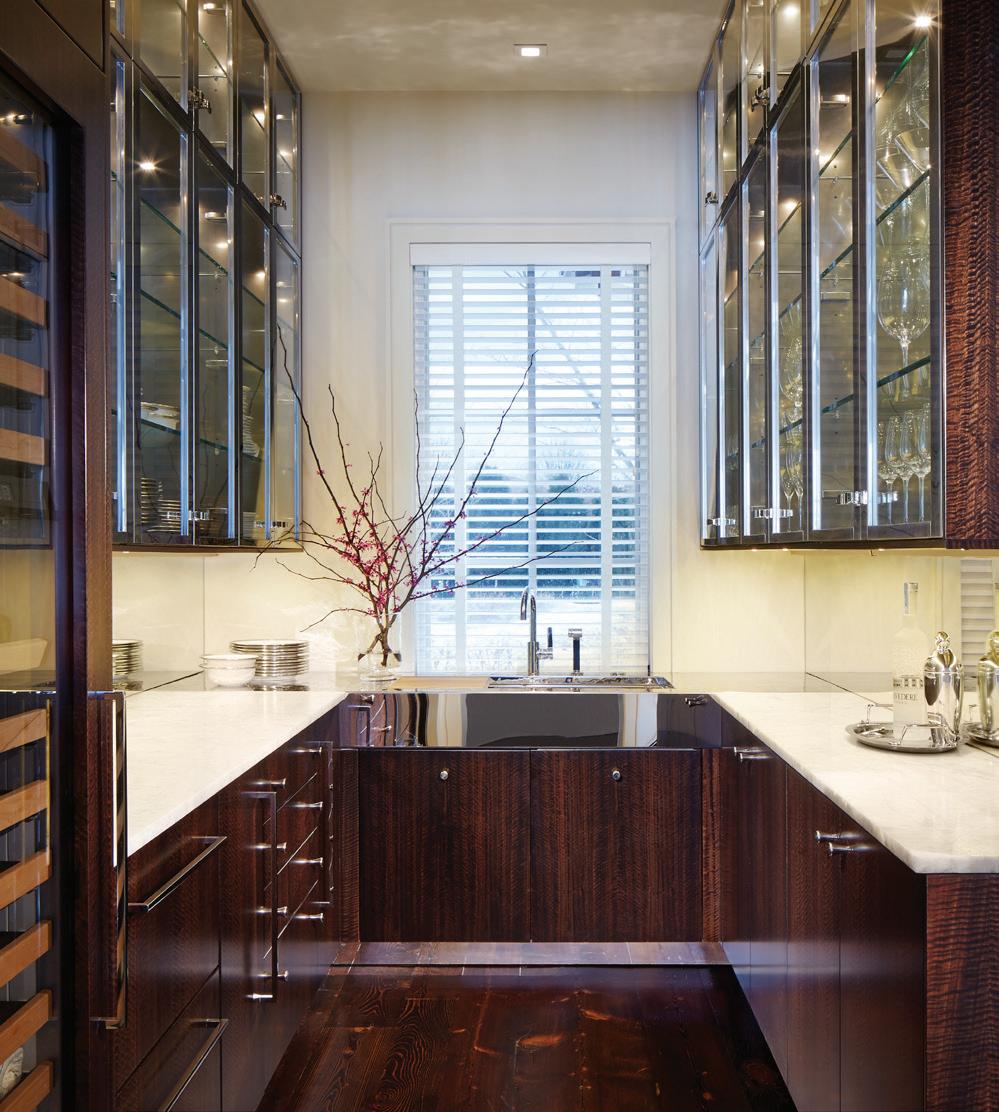

Butler’s pantries and walk-in pantries continue to be highly popular and are functional winners. The back kitchen is the third and newest adjoining area to support the main kitchen. Back kitchens can be large or small and can include everything from small appliance stations to fully appointed and functioning spaces with all appliances. Among the advantages, they free up the main kitchen for entertaining and hide the clutter.
The Art of Lighting
LED lighting technology has changed everything, especially now that the color spectrum can be warm, soft, and elegant. Arguably, the kitchen has more opportunity to layer lighting
10 THE LIVING KITCHEN | ISSUE 1
Left and Above: Adjoining spaces such as butler's pantries and back kitchens can free up the main kitchen for entertaining.
EXPERT Advice
than any other space in a house. Decorative fixtures using LED technology continue to be designed as pieces of art. Even what was once considered basic utility lighting is being done with LED lighting. A great example is Sub-Zero’s new interior refrigeration lighting system, which provides better visibility, eliminating shadows and flattering the interior contents. And maybe best of all, LED is environmentally friendly.
Material Engineering
Long strides have been made in the engineering of wood flooring and veneers, as well as synthetics such as porcelain and laminates. Warping and moving of wood flooring is now more highly controlled with engineered wood boards. Wider planked boards are now more feasible and, unlike the engineered wood floors of the past, can be refinished multiple times. Once considered less expensive and less luxurious alternatives, porcelains and plastic laminates have entered the luxury-level category and can be not only beautiful, but also unrivaled in their durability.
Metal
There is a sense of elegance and permanence when metals are used in the design. Used alone or as complements to other basic building blocks of wood, stone, and glass, the result is a feeling of precision, depth, and more visual texture. Warm metals like brass or silicon bronze in raw or burnished and patinated finishes can be mixed with white metals like stainless steel and German silver. Even a small amount of metal can go a long way, such as using ¼-inch metal inlays in wood flooring or paneling.
Changes to Proportions
One of the ways to make something look new and more highly evolved in a kitchen is by making subtle changes to the age-old proportions. An example is challenging and re-proportioning the standard 1 ¼-inch to 1 ½-inch thickness of countertops. Instead, you can explore using both 4-inch thick with razorthin ¼-inch countertop thicknesses within the same space.

Quartzites
Over the past ten to15 years, stone used in kitchens has migrated from granites, marbles, and synthetics, like quartz, to the classification of natural stone known as quartzite. Although there are some varieties that are better for kitchen use than others, this natural stone is typically dense and hearty and stands up to a hard-working space. Many new varieties of quartzite are still being discovered and quarried every year. It is this designer's opinion that there has never been a more beautiful and practical material for kitchen countertops.
The Why
All of these trends reinforce what people are looking for today in kitchen design: high function, design and material durability, and comfort. The variable is the degree of creativity and interpretation with which each is executed.
To see some of Mick De Giulio’s design projects and to purchase his books, Kitchen and Kitchen Centric, visit: degiuliodesign.com
11ISSUE 1 | THE LIVING KITCHEN
Timeless Design, Fresh Features
SUB-ZERO HAS RAISED THE BAR ON PERFORMANCE AND STYLE WITH NEW FEATURES ACROSS BOTH THE CLASSIC AND DESIGN SERIES.
Forthe very first time, Sub-Zero is releasing the entirely reimagined Classic and Designer Series products together. With a bevy of innovations and exciting features that apply to both series, Sub-Zero is raising the bar for excellence in refrigeration.
With improved performance features and interior aesthetic enhancements, the Classic and Designer Series provide a single story on food preservation: best in class. Sub-Zero offers the widest selection of refrigeration solutions, providing true design flexibility to complement, anchor, or disappear completely into your décor.

The Classic Series’ iconic grille has served as an irrefutable badge of Sub-Zero’s quality for over six decades. While this distinct symbol of its predecessor’s pioneering performance remains, the completely redesigned Classic Series—with its fresh suite of innovative features—reaches new levels of refinement both inside and out.
The newly reimagined Sub-Zero Designer Series is just as seamless and subtle as before. Now, however, its sophisticated aesthetic rivals only that of its performance. Hidden behind fully integrated panels, you will find a mesmerizing collection of features highlighting the line’s seamless, sophisticated look and superior capabilities.
12 THE LIVING KITCHEN | ISSUE 2
NEW PRODUCTS Built-In Coffee System
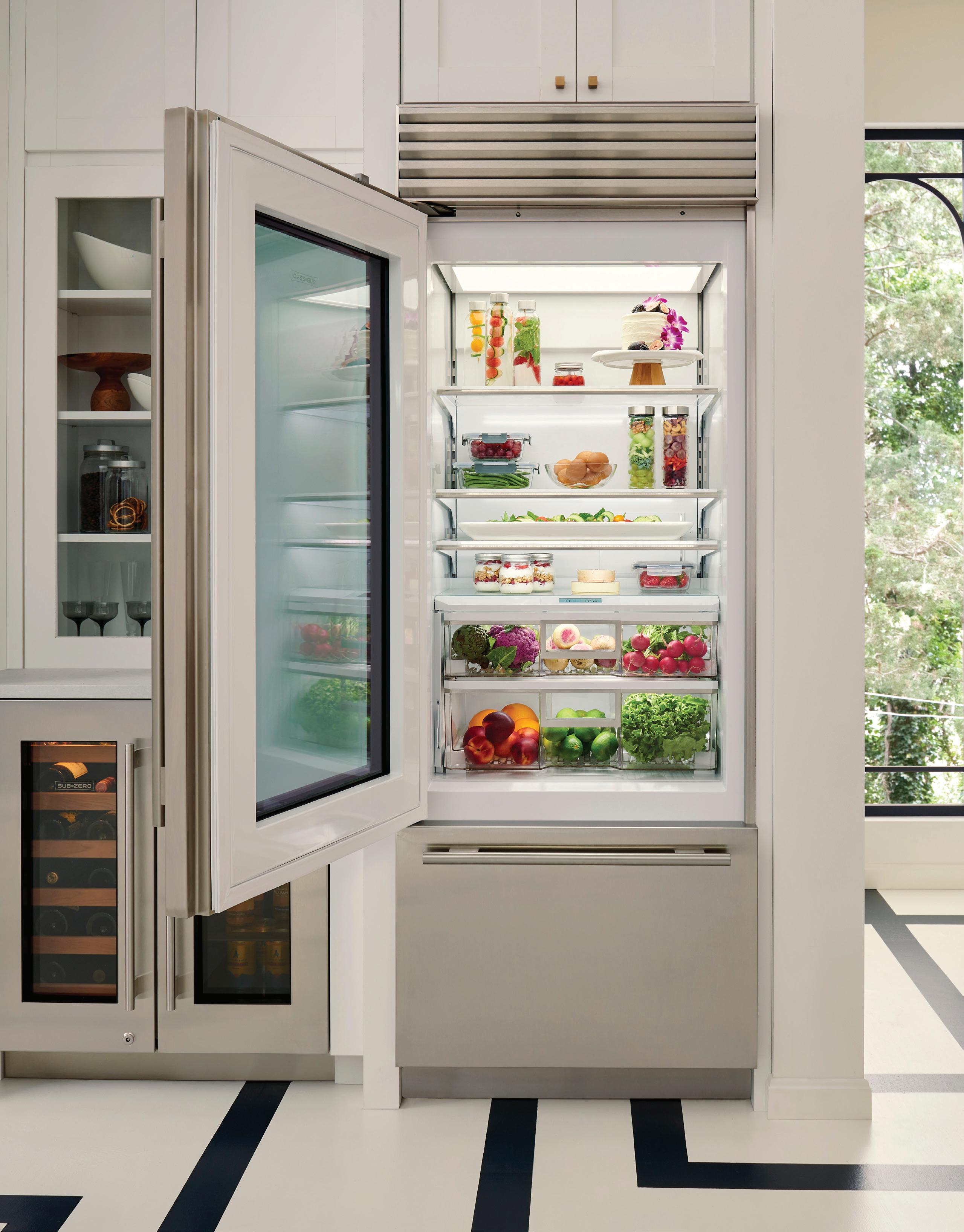
Split Decision
Sub-Zero, the Preservation Specialist, just found a way to make food last even longer. The newly invented Split Climate™ Intelligent Cooling System revolutionizes Sub-Zero’s already-superior preservation capabilities, keeping food even fresher for longer thanks to a variable-speed compressor and two fans that consistently optimize the refrigerator temperature within one degree of set point.
Two independently controlled zones provide the flexibility for precise temperature control and optimized humidity within the refrigerator. These two microclimates—upper cavity and crisper drawer— create a tailored preservation system to keep food fresher, longer.
Touching Base
Control your refrigerator with the touch of a finger and conveniently customize settings—from lighting to humidity—with a tap. The Touch Control Panel has been relocated for greater accessibility, now located at the waist level above the crisper drawers.

Some Light on the Subject
Customers expressed that they wanted “to see light, not lights,” and Sub-Zero’s design and engineering teams responded. The new ClearSight™ LED Lighting system fully illuminates the interior, adding light where it’s needed most—overhead, under each shelf, and in each crisper drawer. Even when brimming with food, the consistent lighting fills the entire unit, and the gleaming white interior reflects light back into the space, eliminating dark spots and reducing shadows.
Importantly, LED lights are fully enclosed and sealed from liquid migration inside or on the surface of the glass shelf. Owners can wash and clean shelves as normal, as they are engineered to be submerged in water for up to thirty minutes.
Customers also asked for automatic brightness adjustments. Thus, the new Night Mode optimizes the interior lighting based on the detected ambient light, reducing the brightness by 90 percent in dim environments.
14 THE LIVING KITCHEN | ISSUE 2 NEW PRODUCTS Built-In Coffee System

15ISSUE 2 | THE LIVING KITCHEN
Sleek and Stainless
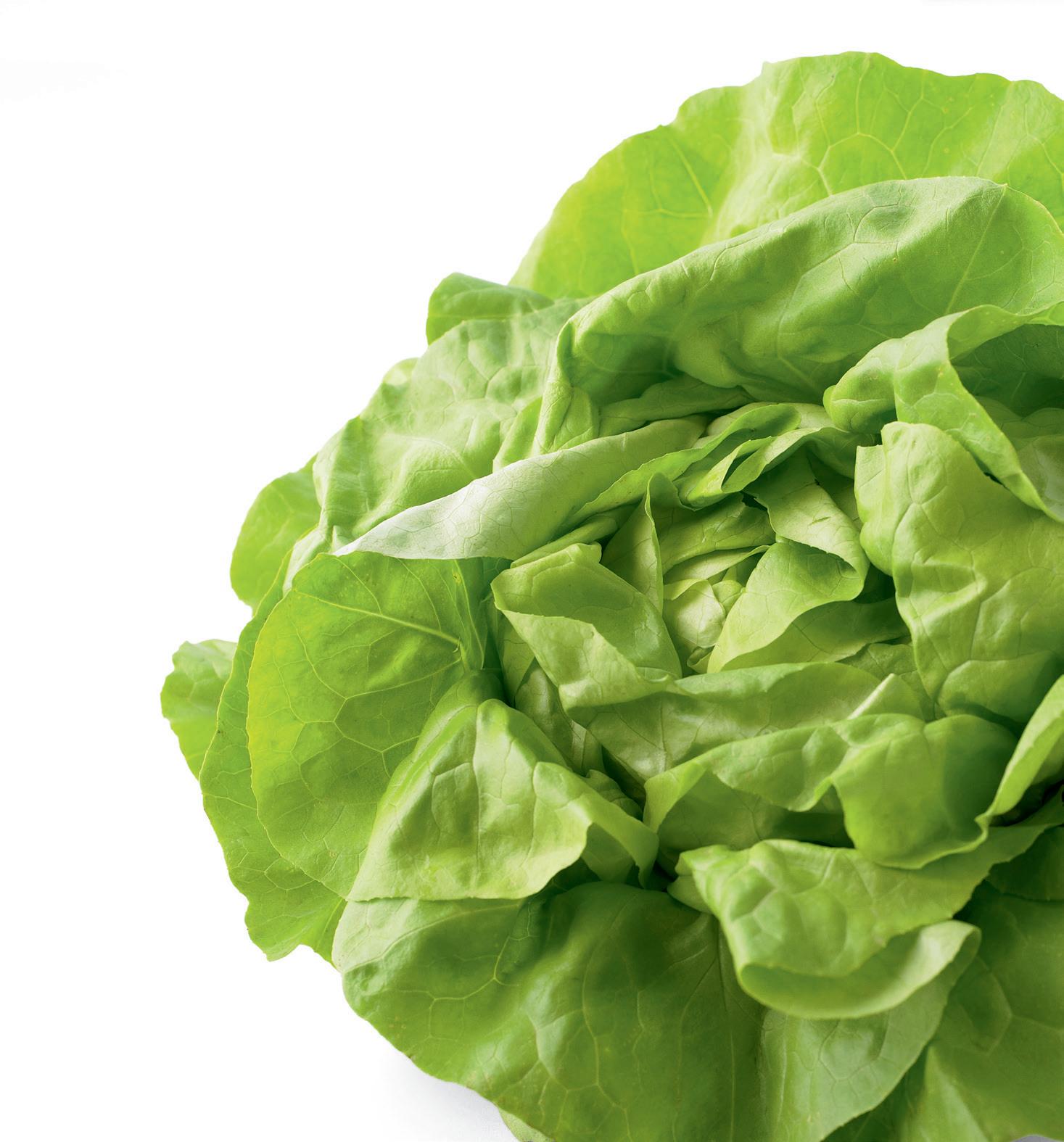
Streamlined stainless accents now trim the interior, matching the sophistication of the exterior, giving customers the kind of luxury they can see, feel, and touch both inside and out.
Incorporating the iconic Sub-Zero stainless aesthetics, Stainless Accents trim all shelves, crisper drawers, and door bins in both Classic and Designer Series units.

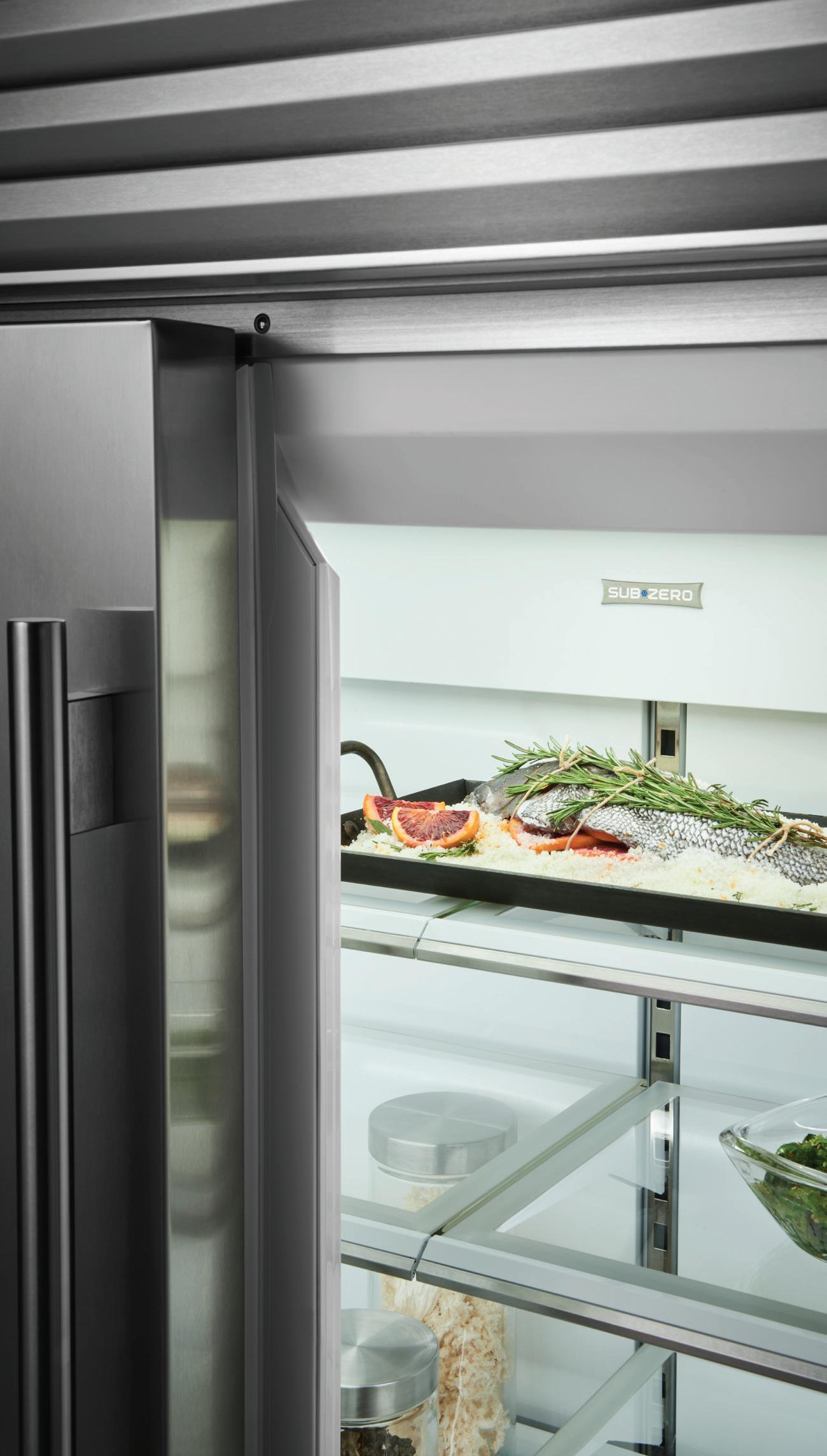
Wifi Capable

16 THE LIVING KITCHEN | ISSUE 2
Left: Stainless Accents add elegance and polish in both Classic and Designer Series units.
NEW PRODUCTS Induction Range
Fun Fact: Two microclimates—upper cavity and crisper drawer—create a tailored preservation system to keep food fresher, longer.

Custom Fit
Sub-Zero customers appreciate greater interior flexibility that can accommodate and best fit their needs. Reimagined Refrigerator and Freezer interiors allow for greater storage customization.
Needing to store taller items? Lift the base of the flip-up dairy compartment to securely store items upright, eliminating the need for tipping them on their side.
Position adjustable shelves—on the inside of the door and within the refrigerator—at various heights to create customizable configurations to best meet your storage needs.

Flexible features are also available in the freezer of Classic Series French Door models, including an Expandable Freezer Basket to accommodate taller items. The base of the basket conveniently slides out of the way, providing a unique storage solution.
A Fold-Up Freezer Shelf, conveniently located beside the compact ice maker, is available in the Classic Series Side-by-Side models, folding up or down to maximize storage space flexibility. (Extra ice cream, anyone?)
17ISSUE 2 | THE LIVING KITCHEN

TECHNOLOGY
APP IN ACTION
GET THE MOST OUT OF YOUR APPLIANCES WITH IN-APP CONTROLS AND RESOURCES—RIGHT AT YOUR FINGERTIPS.
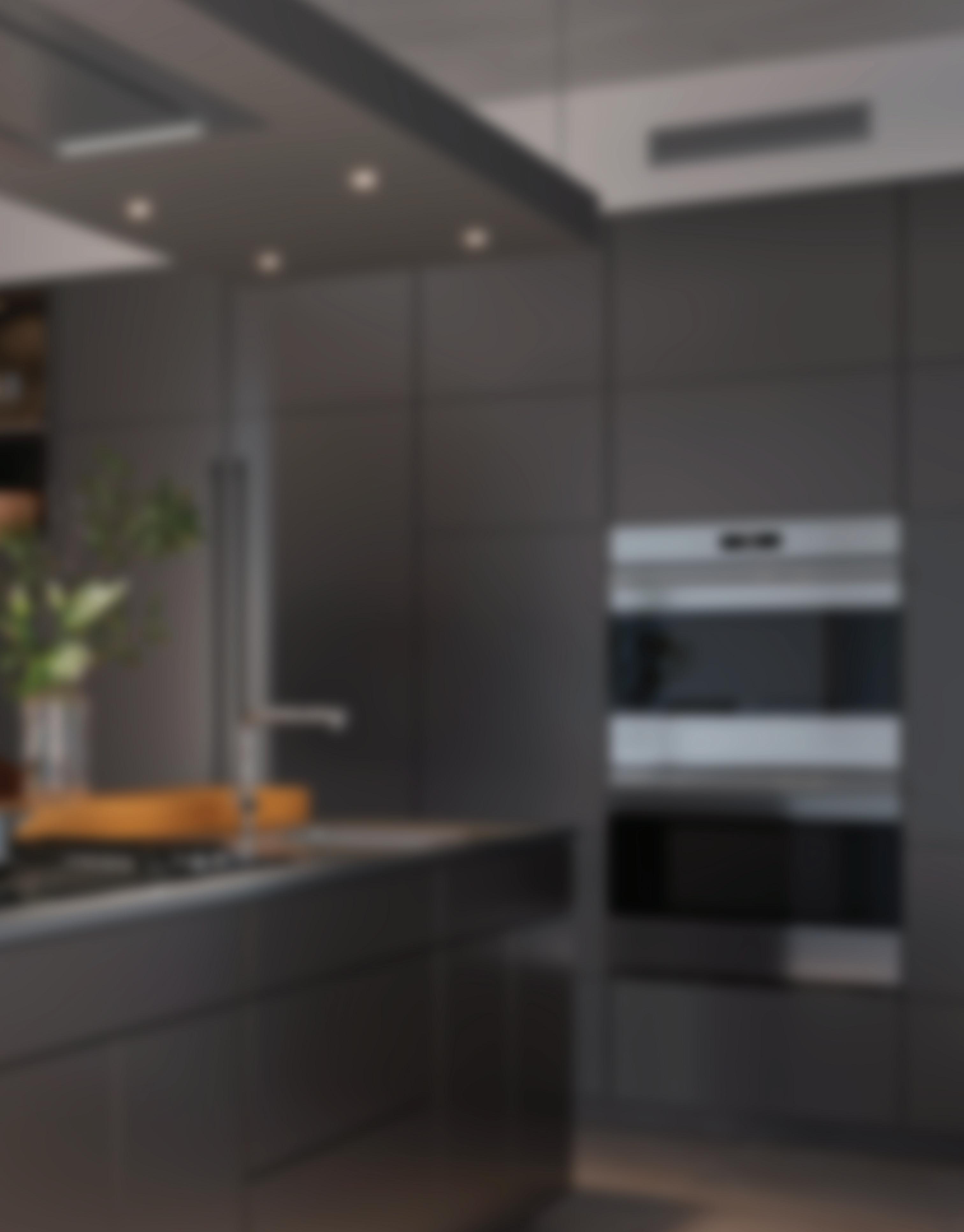
Sub-Zero, Wolf, and Cove customers are learning firsthand how our Wi-Fi-capable appliances and the associated mobile app offer convenience, optimal performance, and access to all the amazing resources our products offer.
Daniel Sage is a Madison, Wisconsin, area stay-at-home dad whose family has discovered all the ways the connected app can simplify their lives. “What’s really nice is using the phone/watch integration with the app to let us know when the oven is preheated or the cooking time is done,” says Sage, who owns an E-Series built-in Wolf oven. “One of the nice things about our family is that I’m here with the kids so we don't usually have both of us getting home at the same time and trying to get the oven going for dinner, “says Sage. “But I can definitely see how busy families with two working people in the household would use the remote start functionality.”
Another function the app offers Sage is peace of mind that his oven is working properly. “It helps make sure that everything is going well,” he says. “It will give you an
alert for routine maintenance.” In fact, one of the most popular capabilities of the Wi-Fi-connected appliances and app is the auto-replacement system for filters and detergent. “A further benefit is the little tips that give you a better idea of how to use the oven within a particular mode,” he says.
Sage has even found that app-facilitated temperature control is conducive to harmonious family life.
“We were making a pumpkin pie for Thanksgiving and we needed to have the temperature up to 425 initially, but then we needed to switch it to a lower temperature after 15 minutes of cooking.” He and his wife happened to be doing their children’s bedtime routine at that moment.
“I was upstairs reading with one of my kids and my wife was in the other room with the other one, and the oven timer went off,” says Sage. “I didn’t want to get up out of my chair, because my little girl was sitting on my lap,” he says, “so I just grabbed my phone and dropped the temperature of the oven through the app. That was super nice!”
ENHANCE YOUR SUB-ZERO, WOLF, AND COVE EXPERIENCE
Connect to the Sub-Zero Group Owner’s App to select cooking modes, monitor meals remotely, set and monitor dishwasher cycles, receive timely notifications, and more.
unparalleled performance not changed, technology has. Sub-Zero, Wolf, and Cove appliances, you convenience in your palm. ensures your always perform best.
unparalleled performance has not changed, technology has. Sub-Zero, Wolf, and Cove appliances, you convenience knowledge ultimately ensures your always perform best.
Coming
Coming
You will also need a Sub-Zero, Wolf, or Cove connected appliance, a wireless router, and internet connection with your network name and
You will also need a Sub-Zero, Wolf, or Cove connected appliance, a wireless router, and internet connection with your network name Apple, the Apple logo, iPhone, and iPad are trademarks of Apple Inc., registered in the U.S.

Classic Apple Pie
This apple pie recipe takes advantage of the Auto Steam Bake Mode’s ability to make a beautiful, glossy top crust.
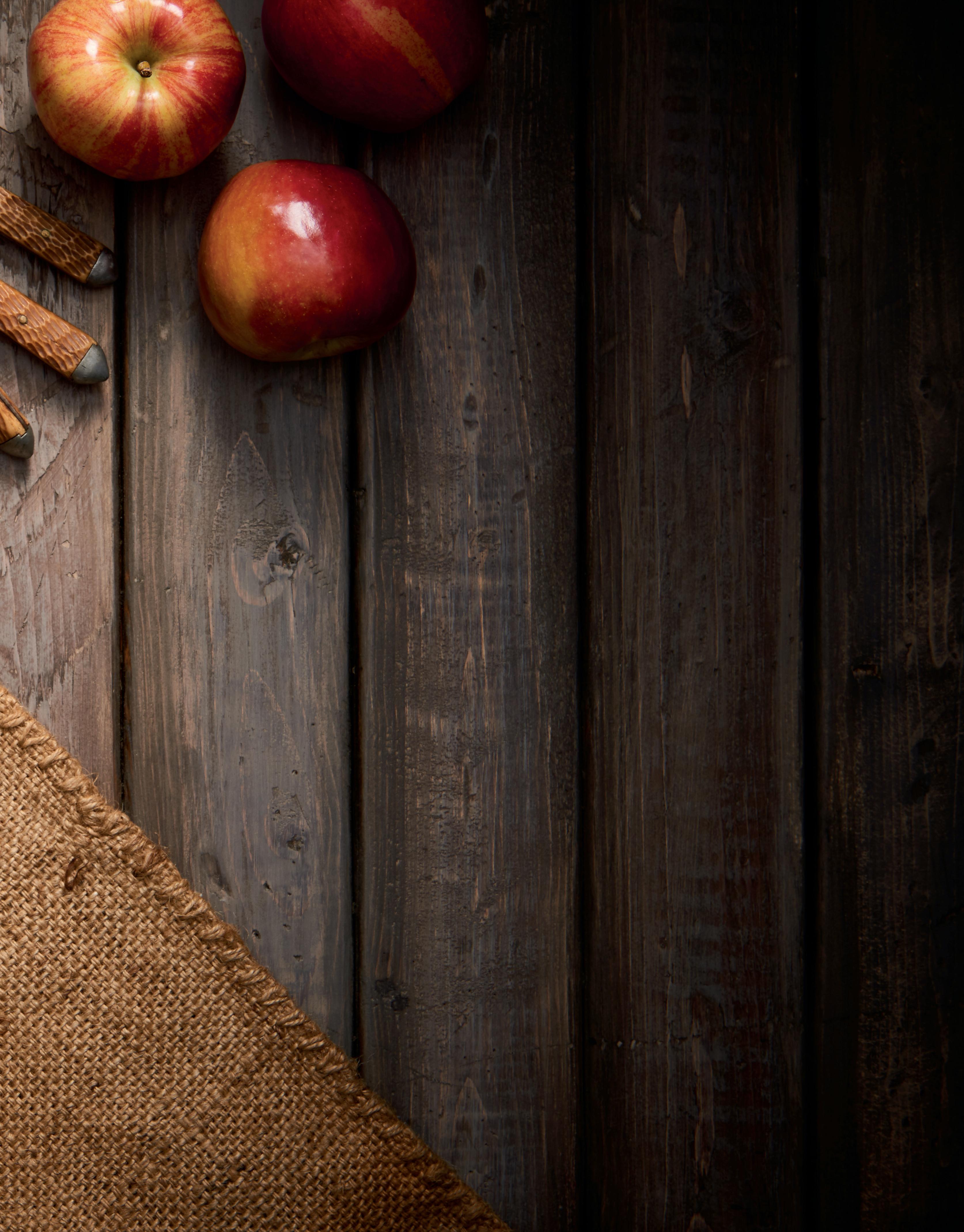
MAKES: 1 pie
INGREDIENTS:
Pie Crust
2 2⁄3 cups all-purpose flour 1 teaspoon salt
1 cup + 2 tablespoons shortening
7 tablespoons cold water
Apple Mixture
*7 medium apples, peeled, quartered, and sliced ¼ inch thick
1½ cups sugar
¼ cup all-purpose flour
1 tablespoon corn starch 2 teaspoons lemon juice
1 teaspoon cinnamon
¼ teaspoon nutmeg
2 tablespoons butter
*It is best to use a couple of different kinds of baking apples, as they will each lend their own flavors and nuances to the dish.
PREPARATION METHOD
In a large bowl, combine all the pie crust ingredients. Crumble lightly together until well combined. Mix in the cold water and bring the dough together with a fork. Divide the dough into two pieces and set one back in the bowl. Cover with a damp towel. Roll out the first piece of dough on a generously floured surface until about 1⁄8 inch thick, or large enough to cover the bottom and side of a pie pan. Place the rolled-out dough in a pie plate or dish. In another bowl, combine apple mixture ingredients. Pour the apple mixture into the prepared pie dish. Place the 2 tablespoons of butter on top of the apple mixture in small pieces. Roll out the remaining dough into a top crust and place on top of the pie. Crimp the edges of the pie and cut off any excess dough. Cut a few small vent slots in the top of the crust. Place on the wire rack set on position 2. Select the Auto Steam Bake Mode set to 440°F. Set the timer for 30 minutes.
After 30 minutes, open the oven and rotate the pie. Reduce the temperature to 400°F and set the timer for 20 minutes. After 20 minutes, remove the pie and place on a cooling rack. Allow to cool for 45 minutes before serving.

Bathroom Bliss
A sensational view of a tranquil hillside greets you from a stunning stand-alone tub in this expansive and luxurious resort-like bathroom. Combining the richness of natural wood with the cool blues of an hexagon floor tile and patterned backsplash, the retreat is a feast for the senses. A designer series Sub-Zero 15-inch wine and beverage center holds cold drinks, while the Wolf coffee maker above offers warm refreshments for an indulgent spa day at home.
BEYOND
THESE ALLURING ROOMS ALLOW YOU TO RELAX AND ENTERTAIN IN STYLE. KITCHENthe

23ISSUE 1 | THE LIVING KITCHEN
Party Prep
Entertaining is pure pleasure from this sleek butler’s pantry, where style meets convenience. The contemporary black trim on the Wolf convection microwave and the rich wooden shelves of the Sub-Zero wine storage unit are both striking against the midnight blue cabinetry. The distinctive arched handles on the doors and drawers echo the glimpse of stored wine bottles and complement the gray swirled tile on the countertop and backsplash.

24 THE LIVING KITCHEN | ISSUE 1
Bar & Lounge
The owners of this suburban Chicago area home from Patrick J Murphy Builders, wanted a warm and inviting gathering place just off their kitchen. The “hearth room,” as they call it, is a comforting retreat for all members of the family, who can enjoy their drink of choice from the built-in wet bar that features an under-counter Sub-Zero beverage refrigerator and a Sub-Zero wine storage unit. Ebony cabinetry is set against cool white walls, with an etched mirror backsplash reflecting the fireplace across the room.
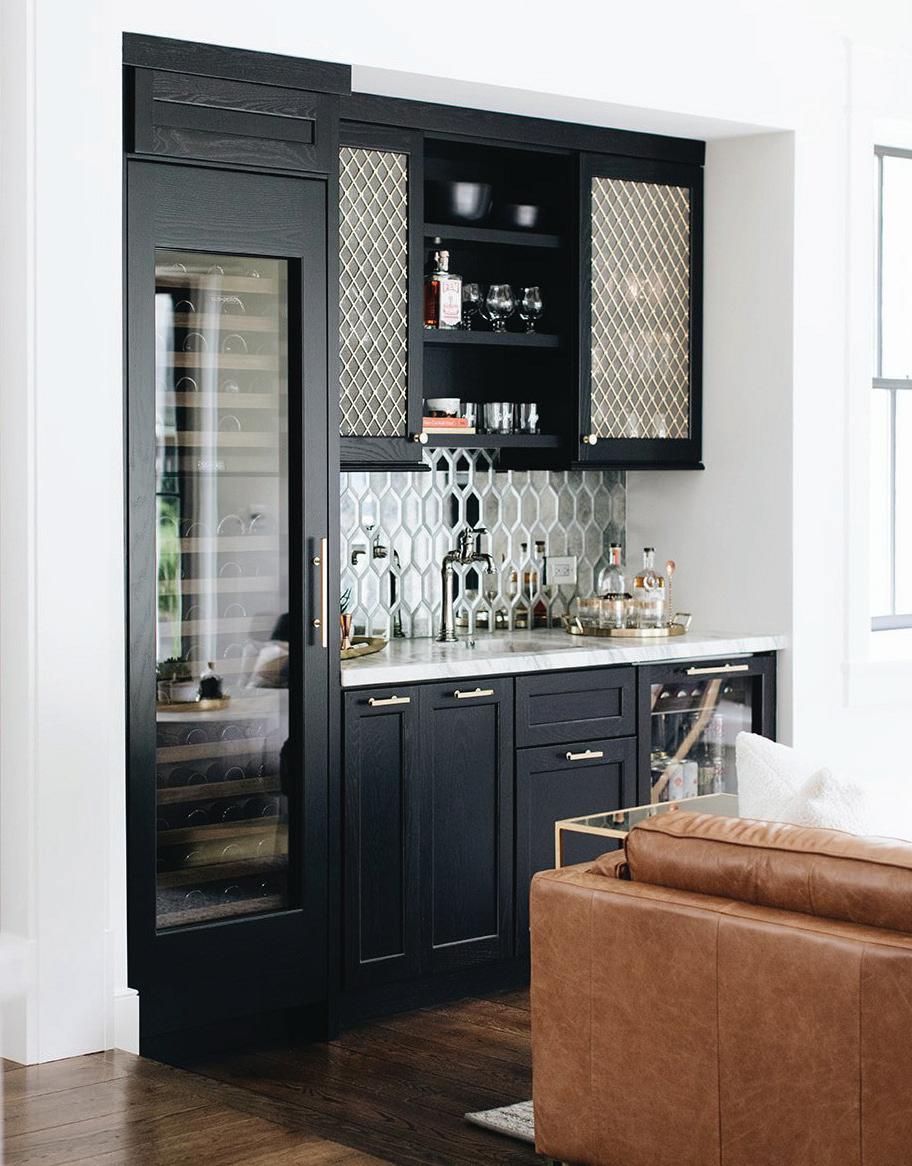
25ISSUE 1 | THE LIVING KITCHEN Stoffer Photography Interiors
A winning kitchen from celebrated designer Matthew Quinn melds classic style with innovative composition. ENDURING DESIGN
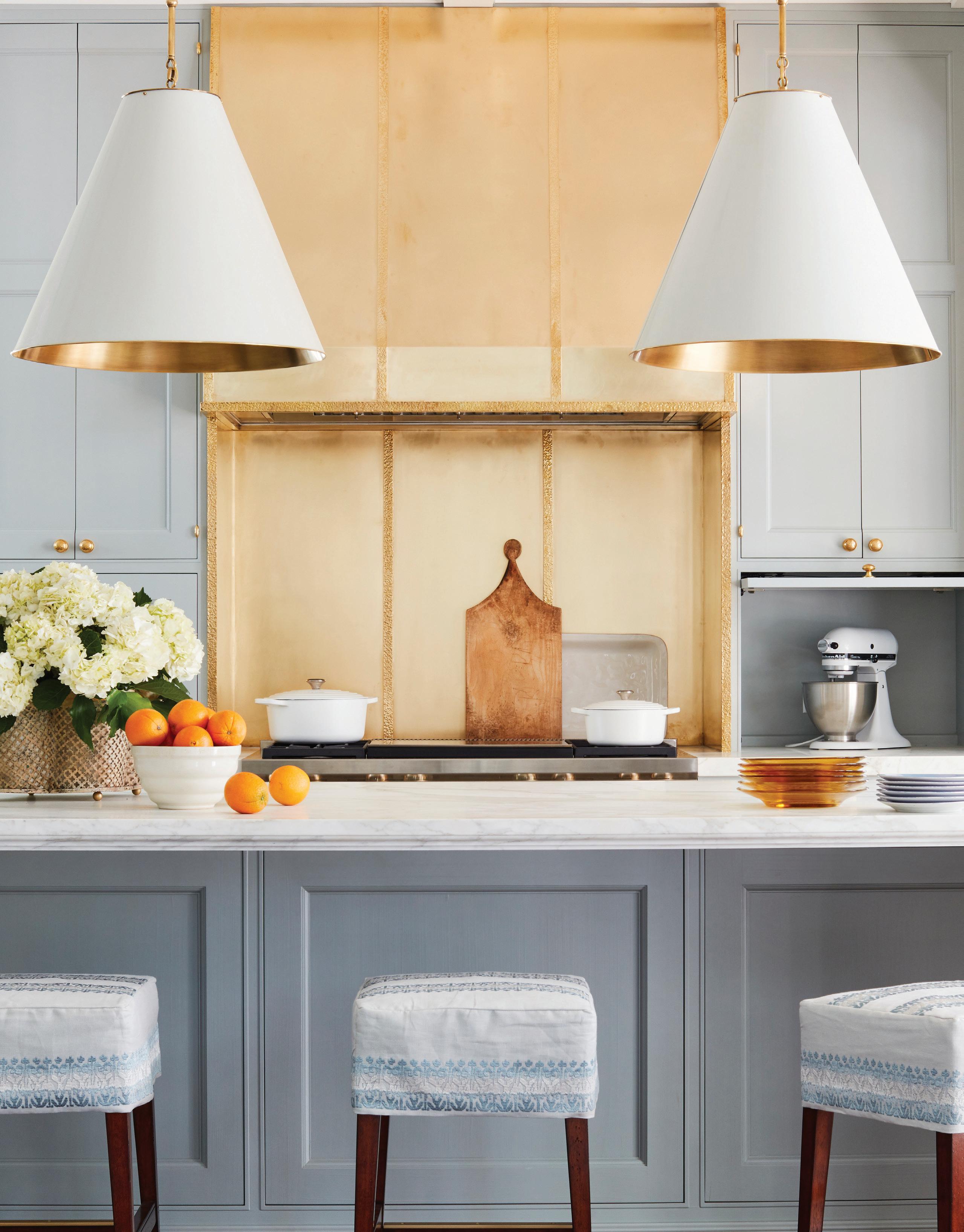
The stunning and serene kitchen that was awarded the first place Traditional Award in the 2017-18 Sub-Zero Kitchen Design Contest was a renovation project in a historically significant home in the Buckhead neighborhood of Atlanta. Matthew Quinn, principal of Design Galleria Kitchen and Bath Studio, collaborated with architect Yong Pak, builder Michael Ladisic, and interior designer Lauren DeLoach to create a functional and fabulous-looking space for a growing family. “This kitchen is part of a new addition to the home, and it was my job to make it seamlessly flow with the existing structure,” says Quinn. “I was given an opportunity to make it work well for the busy homeowners.”


The designated kitchen space was originally one large rectangle open on two sides. Quinn noted that having only two walls for storage wouldn’t be enough for a family that cooks together daily. “My solution was to add a wall in the kitchen and create two separate spaces,” he says. “One side became the kitchen and the other a working pantry.”
Starting from a phenomenal custom-designed range hood crafted of elegant, hammered metal, Quinn worked outward, adding thoughtful design details throughout the kitchen. “I wanted the visual attention to be put on the hood, so I designed wall cabinets that appear to be a single door cut in half to give the feeling of columns flanking this amazing hood.”
Aperoreptate ex eum quatia dolendis aut aniassi tiamus aliquiatem acerum iusdant, se autentur\
The gold tone of the hood is replicated throughout the kitchen in the decorative brass fittings. “Brass is timeless,” says Quinn, who explains that in order to finish the project within the deadline, he laid out all the unlacquered brass hardware in the back of his company’s offices. He then asked every employee to touch every piece each time they passed by. “Eventually, it turned into that gorgeous patina that we were going for.”
“We then translated the peening technique on the range hood’s strapping, using a much larger peening hammer,” says Quinn. The combination of brass and hammered strapping gives the hood some historical relevance, relating it to the classic home.


Quinn’s team also took the removable handle from the Wolf range and brought it to a brass plater for finishing. “It was just an extra, special touch,” he says.
Next to the Wolf range, Quinn had a gorgeous radius window installed above a farmhouse sink. “I also added extra depth to that countertop because we knew we wanted lamps there as well,” he says. “It is such a simple element, but it immediately makes it feel a little bit more furniture-like by putting lamps at the window.”
The homeowner also had a unique collection of blue-toned dishes that are displayed on the wall to the left of the window.
30 THE LIVING KITCHEN | ISSUE 2
Tio mo dolorestio. Xerovitatio. Et mintiam, corro blandam, ut hillam quat esectem res por repelic totat harcima
Top left: Twin table lamps frame the radius window and farmhouse sink. Bottom left: The hood above the Wolf range is crafted from peened brass.

The color blue is repeated throughout the entire house, as both husband and wife agreed it is their dual favorite. The kitchen features light blues, while the adjacent butler's pantry has a deeper, more vivid hue. “I wanted your eye to be pulled further along,” says Quinn, “so when you're in the kitchen, you see that vibrant blue in the background. I typically make the color in pantries, or any space you can see through the kitchen, a little bit darker and more intense to draw the eyes to that space.”
The pantry houses the Sub-Zero freezer and ice maker, an additional dishwasher, and a second sink that dispenses sparkling water. Above this smaller sink is an architectural round window, in front of which hangs a tiny chandelier, another nod to the traditional style of the home.

To maintain the stylistic integrity, Quinn was compelled to come up with a clever solution to the waterfall countertop on the island, a request from the homeowners.
“Waterfall countertops which cascade to the floor are typically found in modern homes and kitchens, he says. “This house was not modern in the least, but I knew we could find a way to make it work.” Quinn designed the ends of the island to look like paneled cabinetry, creating a timeless look befitting the residence.
“There are very few craftsmen capable of accomplishing this technique,” says Quinn. "The veining of the countertop has to perfectly match the end panels, which cannot be achieved with one piece of marble. We ultimately needed two extra slabs, and the end result is absolutely breathtaking.”

Quinn has won first place in the Kitchen Design Contest before, in 2008, and also served as a judge for several years. He is cognizant of the significance of the event. “It truly is the Oscars of kitchen design,” he says.
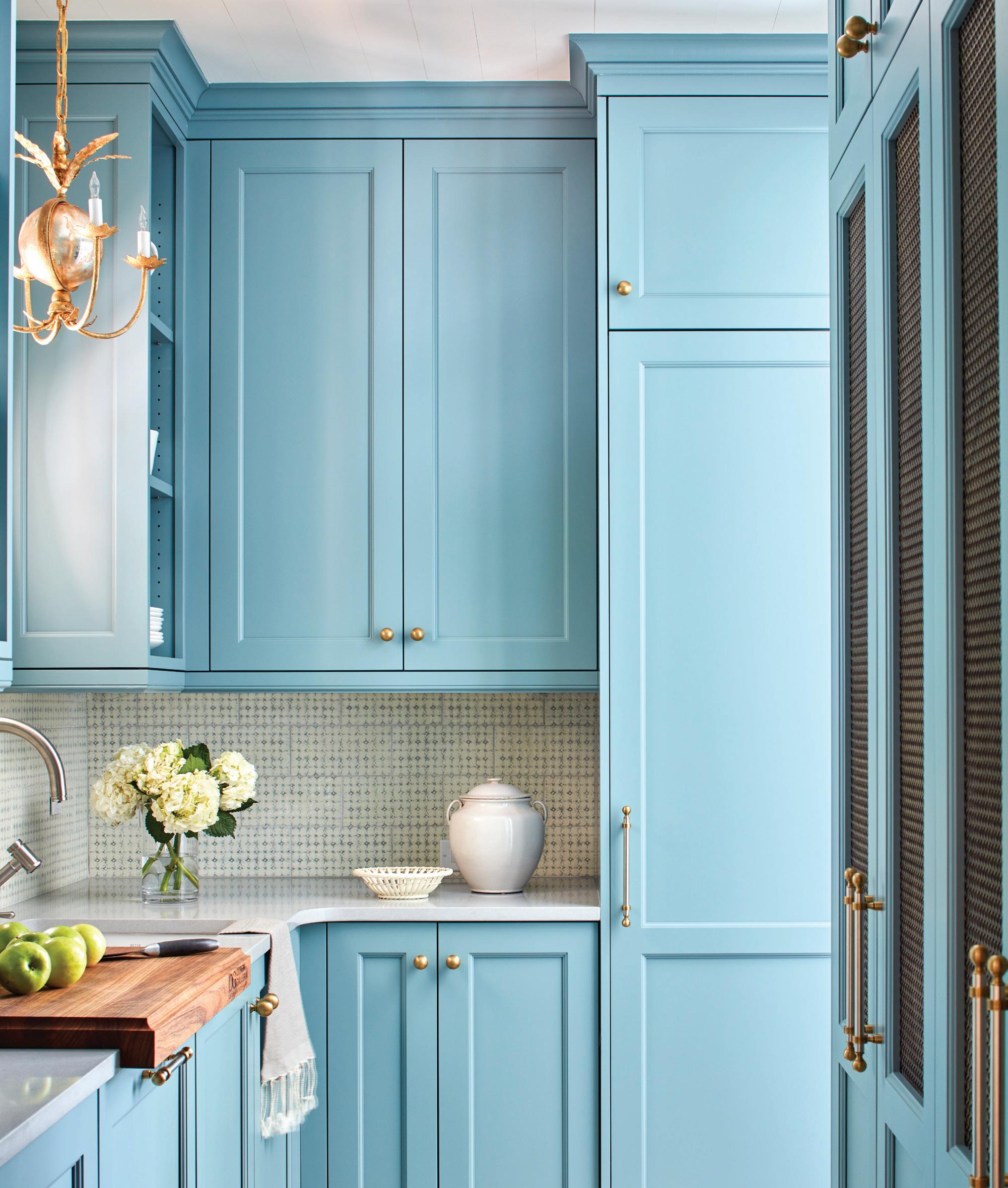
“It is the most recognizable professional honor.” Being an applicant and subsequent winner has clear benefits, but Quinn also gleaned important insight from his
seasons as a judge. “The Sub-Zero group takes the entire process very seriously,” he says, “and the categories have continued to diversify.” He says he was blown away by the quality of the thousands of entries. “It really challenged us as designers to choose winners,” he says. “I think the skill level increases every year, and these kitchens get better and better. I truly loved being a judge!”
33ISSUE 2 | THE LIVING KITCHEN
The nearby pantry beckons with a brighter hue of blue. Opposite: A charming mini-chandelier hangs just above the pantry's porthole-style window.
UNCORK AND UNWIND
A cavern-like wine cellar meant for both storage and celebration is the centerpiece of a New England home.
 By Marni Elyse Katz Photography by Dan Cutrona
By Marni Elyse Katz Photography by Dan Cutrona
This sensational stone and glass-walled wine room reflects the overall architectural theme of the home.
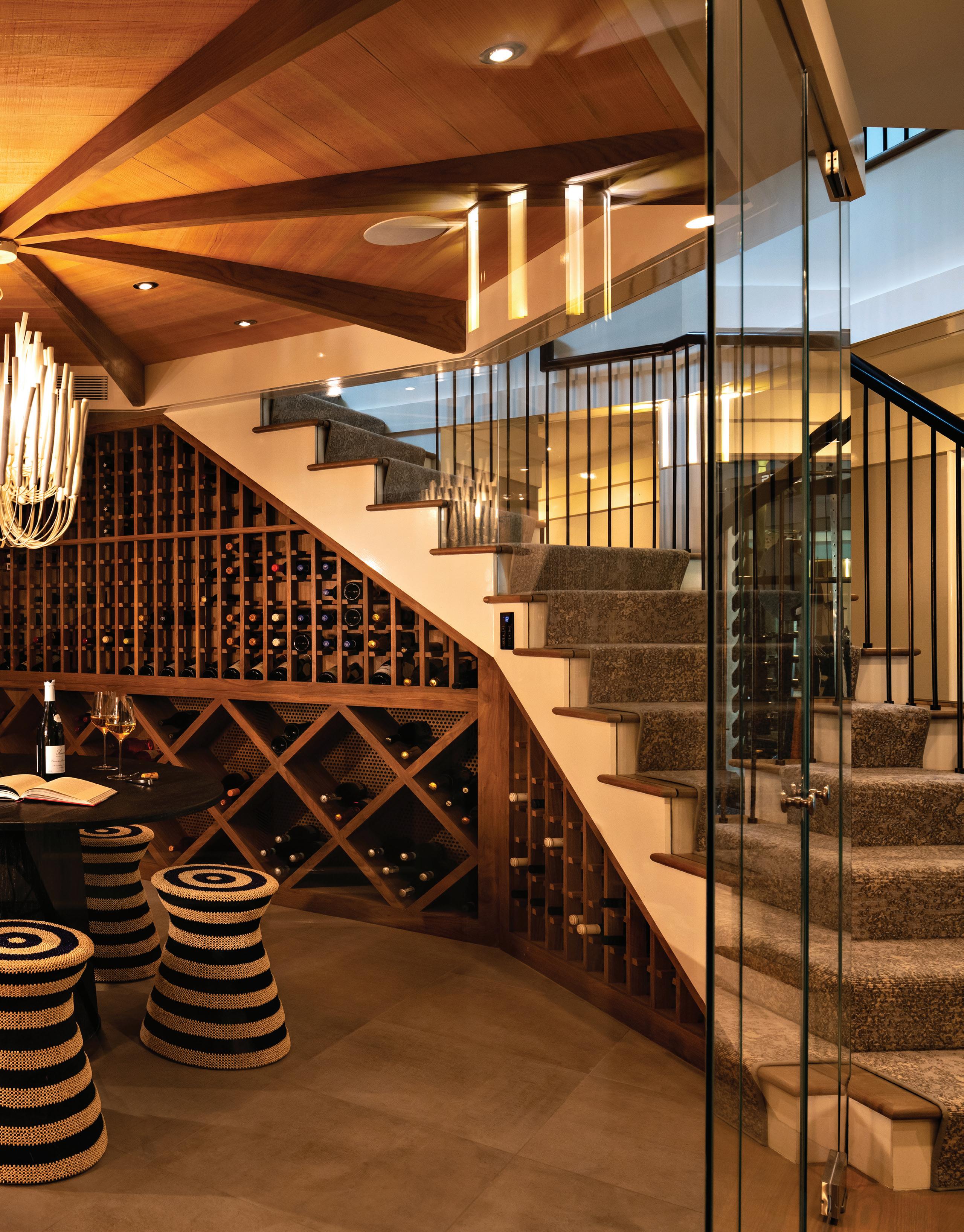
When it came time to flesh out the details of the wine cellar in the 10,000-square-foot home he de signed in Weston, Massachusetts, architect Christopher Pagliaro was reluctant to relinquish the design to specialists. “That only brings in the ‘man likes wine’ clichés and some wine racks,” Pagliaro says. “I said, ‘You’ve got to give me a chance to design it.’”
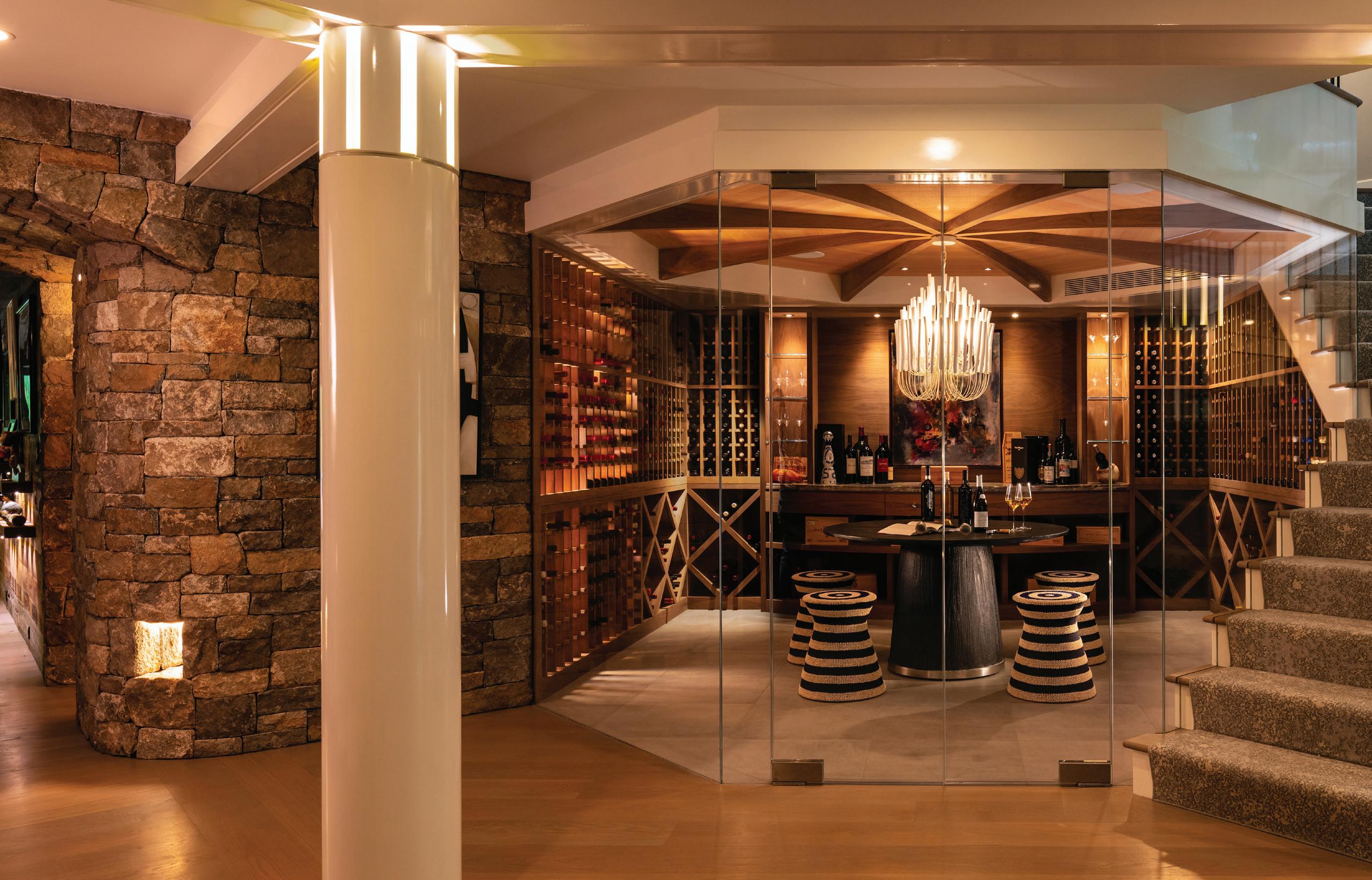
As a luxury architect based in Fairfield County, Connecticut, Pagliaro has designed more than a few wine cellars and tasting rooms in his career. He understands the behind-the-scenes mechanics involved— bottles must be stored at specific tempera tures and humidity levels—and he also considers the personal nuances. How does the collector interact with the collection?
“Once we get past how many bottles they need to store, I ask, ‘What are your goals?’” Pagliaro explains. “This particular client said he wanted people to sit and enjoy conversation with the wine.” The homeowner also felt strongly that the space itself be integral to the experience of savoring the wine and be a dis tinctive feature of the residence. In other words, the wine room should be as celebrated as the wine itself. It was also essential that the wine room fit into the home’s context; it should have a
meaningful dialogue with the home’s overall architecture.
As one descends from the foyer to the lower level, the 800-bottle, stone-walled wine cellar is unveiled, presenting a drawn-out drama. It sets the tone for what’s to come: a formida ble Shangri-La devoted to sensory pleasures.
The stairs, which interior designer John Stefanon covered in a Stark Carpet runner with an acid-spill design, wrap about a third of the multi-sided wine room. While simple, rhythmic bal usters continue down one side of the staircase from the foyer, the wine room’s glass walls function as the opposite banister. “The glass is set flush into the stairs, so it appears to be buried into the steps,” Pagliaro says.
Although the room is actually a hexagon, it feels like an eight-sided space thanks to its octagonal ceiling with walnut planks and beams. The shape replicates, albeit in a smaller size, the octagonal foyer a floor above it. Thus, Pagliaro uses the architecture to reinforce the idea that the wine room is not merely a storage space but a core component of the home. The materials do the same. “The walnut ties to the architectural details in the rest of the house, and [the paneling and shelves] are made by the millworker instead of a wine-rack fabricator,” the architect says. “It also provides warmth without the cliché of mahogany.”
36 THE LIVING KITCHEN | ISSUE 2
Holding more than 800 bottles, the wine cellar is ideal for a connoisseur’s tastes.


The back wall boasts a curved, smoky marble countertop where the owner can uncork and pour vintage wines. Drawers offer storage for tools and books, and beneath, shelves of different heights accommodate cases. Adjacent shelves have single and double deep slots for bottles and dia mond-shaped compartments for unloading and storing vintages that the owner wishes to keep together. The perforated backs of the shelves allow air to be evenly distributed from behind. “The mechanical systems are behind the wine, so you don’t see them,” Pagliaro says.

37ISSUE 2 | THE LIVING KITCHEN
Tio mo dolorestio. totat harcima
Also, behind the shelves? Lighting. On the left, light comes from a stone passageway built to resemble a grotto, complete with pointed arches. The hall leads to an entertainment lounge with a bar, a trio of oversized TVs for watching sports, a pool table, a theater for movie screenings, a workout room, an out door yoga studio, a spa, and even a stone-framed exterior secret garden. “The backlit shelves are about drawing the eye through the room and leading the subconscious,” Pagliaro explains. “If you see light coming from behind, you will be naturally curious and wander over. It’s about making one wonder what’s there.”

The expansive lounge affectionately referred to as “the shack” is outfitted with a Sub-Zero Under-counter Refrig erator and Ice Maker, ready for any beverage. “The clients wanted to feel like they were going on a vacation when they went down there,” Pagliaro says.
Back in the wine cellar, Stefanon’s furnishings com plete the sublime experience. “The striped stools bring life to the room, and the chandelier drops low over the elegant table, defining the center of the room,” Pagliaro says. “It’s saying, ‘Come in and sit down.’”
38 THE LIVING KITCHEN | ISSUE 2
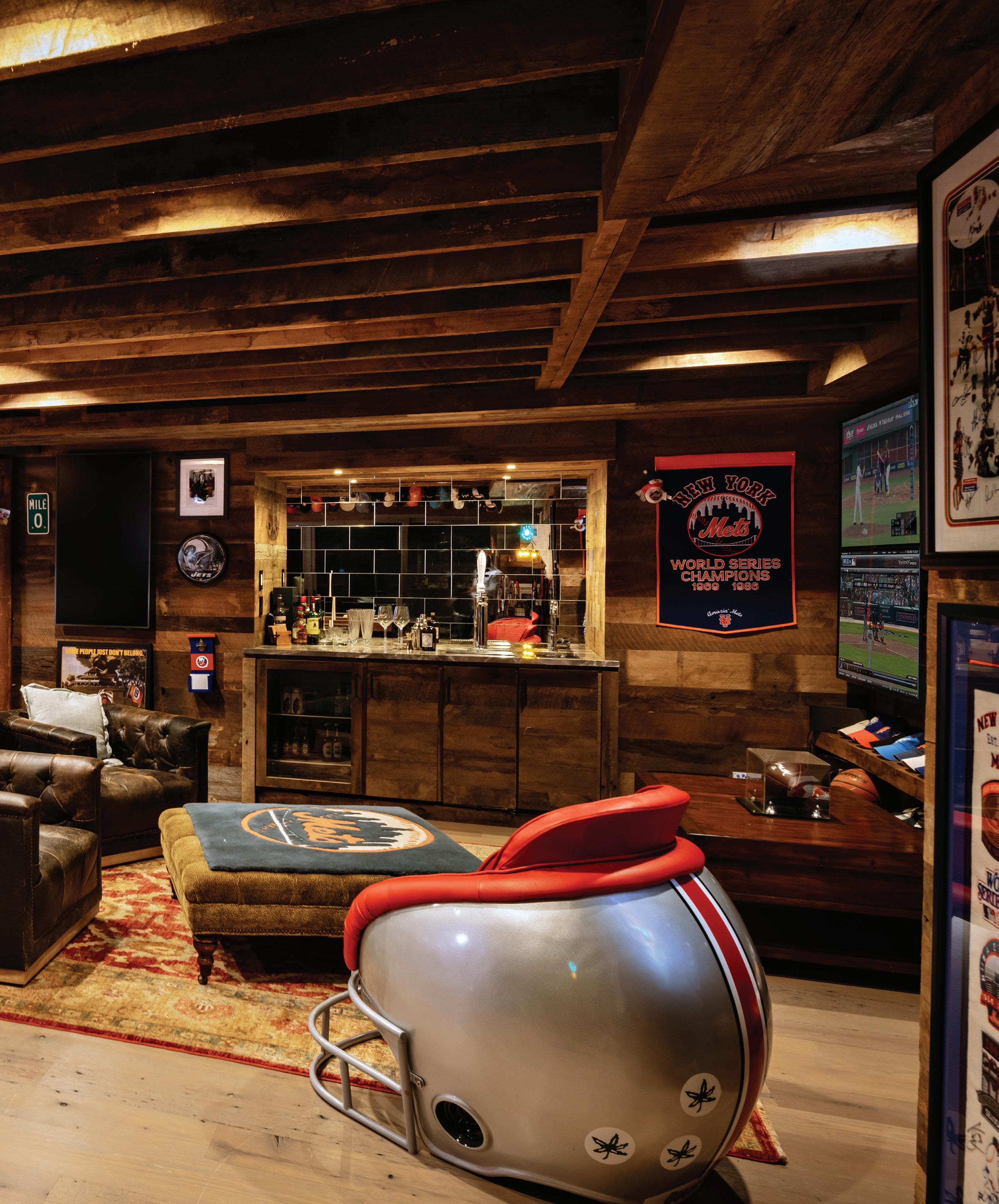
39ISSUE 2 | THE LIVING KITCHEN
DINING And Wining OUT
Wine service at the iconic Smith & Wollensky is enhanced by Sub-Zero’s stunning storage.

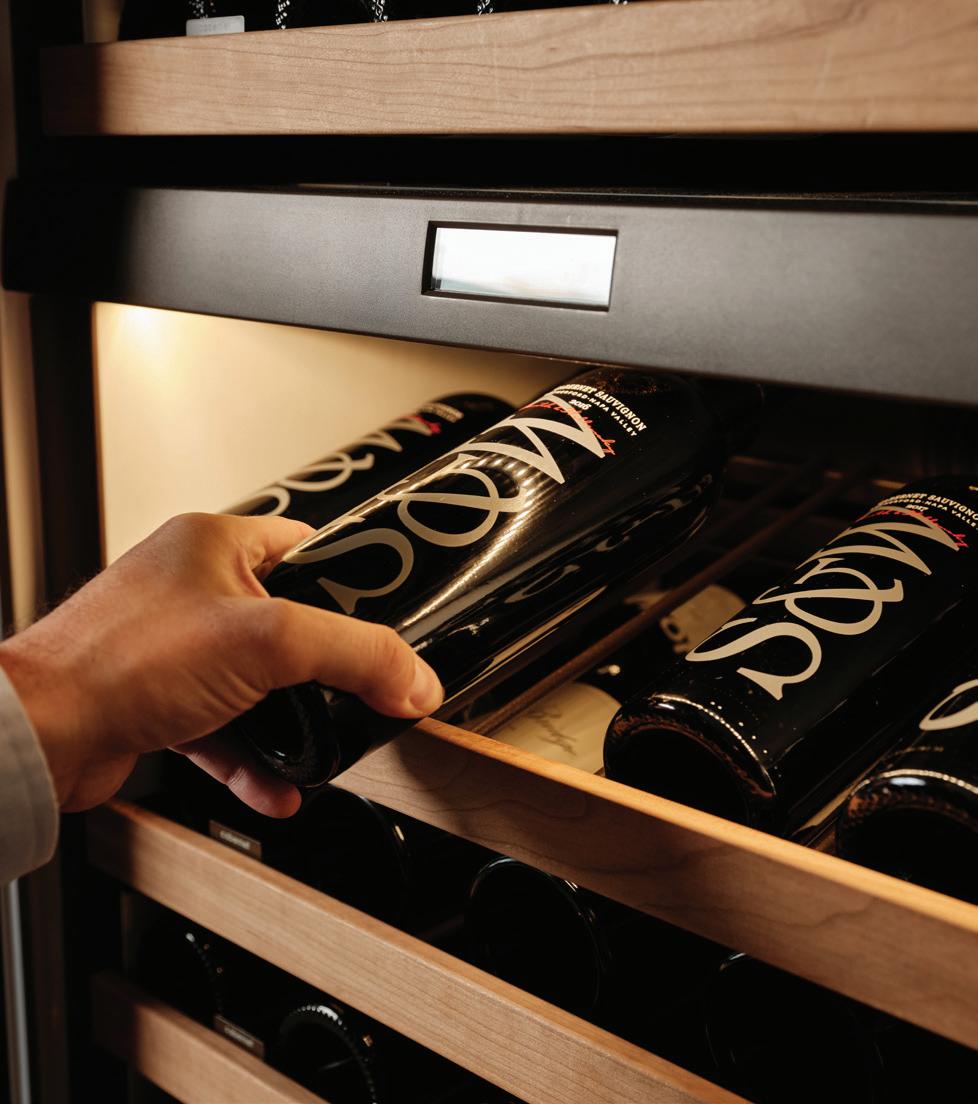
When you sit down to dine at one of Smith and Wollensky's restaurants located across America, not only can you expect to enjoy the finest hand-butchered and dry-aged steaks, but you also will experience a unique wine service.
From the comprehensive wine training regimen for servers to carefully curated vintages, Smith and Wollensky’s Beverage Program’s goal is to give customers an optimal wine journey. “We work really closely with our supplier partners to make sure we have a good level of excellent inventory in every market," says Christian Gianaris, the National Beverage Director for the company. “We have a core wine program for by-the-glass and bythe-bottle sales, but we allow beverage managers at each individual restaurant to select labels that they feel will do well with their guests. It is exciting to see the different palettes that prove popular in different locations.”
What is consistent in each iconic Smith and Wollensky locale are the Sub-Zero wine refrigeration units that house the many bottles available to guests. “From an aesthetic standpoint, they are just beautiful,” says Gianaris. “They are seamlessly incorporated into the public side of the restaurants. It almost looks like the restaurants have been built up around those units.” Gianaris has often noticed customers slowing down to peek inside. “They all have such stunning cabinetry and offer a beautiful display of wines that really draw the eye,” he says.
40 THE LIVING KITCHEN | ISSUE 2
Christian Gianaris sits with a fine vintage in front of Sub-Zero wine storage at the Smith & Wollensky in Wellesley, Massachusetts.


Left: The dining floor at Smith & Wollensky's new restaurant in The Venetian, Las Vegas. Above: Sub-Zero storage keeps wines at the perfect temperature and humidity.
In addition to turning diners’ heads, the Sub-Zero units provide optimum storage environments for reds, whites, rosés, champagnes, and even ports. “When we purchase certain wines, especially when we get into those higher-level wines, it’s good to know that they will be stored at the proper temperature and humidity,” says Gianaris. He adds that sometimes it can take six months to a year before somebody requests a particular wine. “It really eases our minds to know that when we bring the vintage into service, we can count on it having been stored at the ideal conditions.”
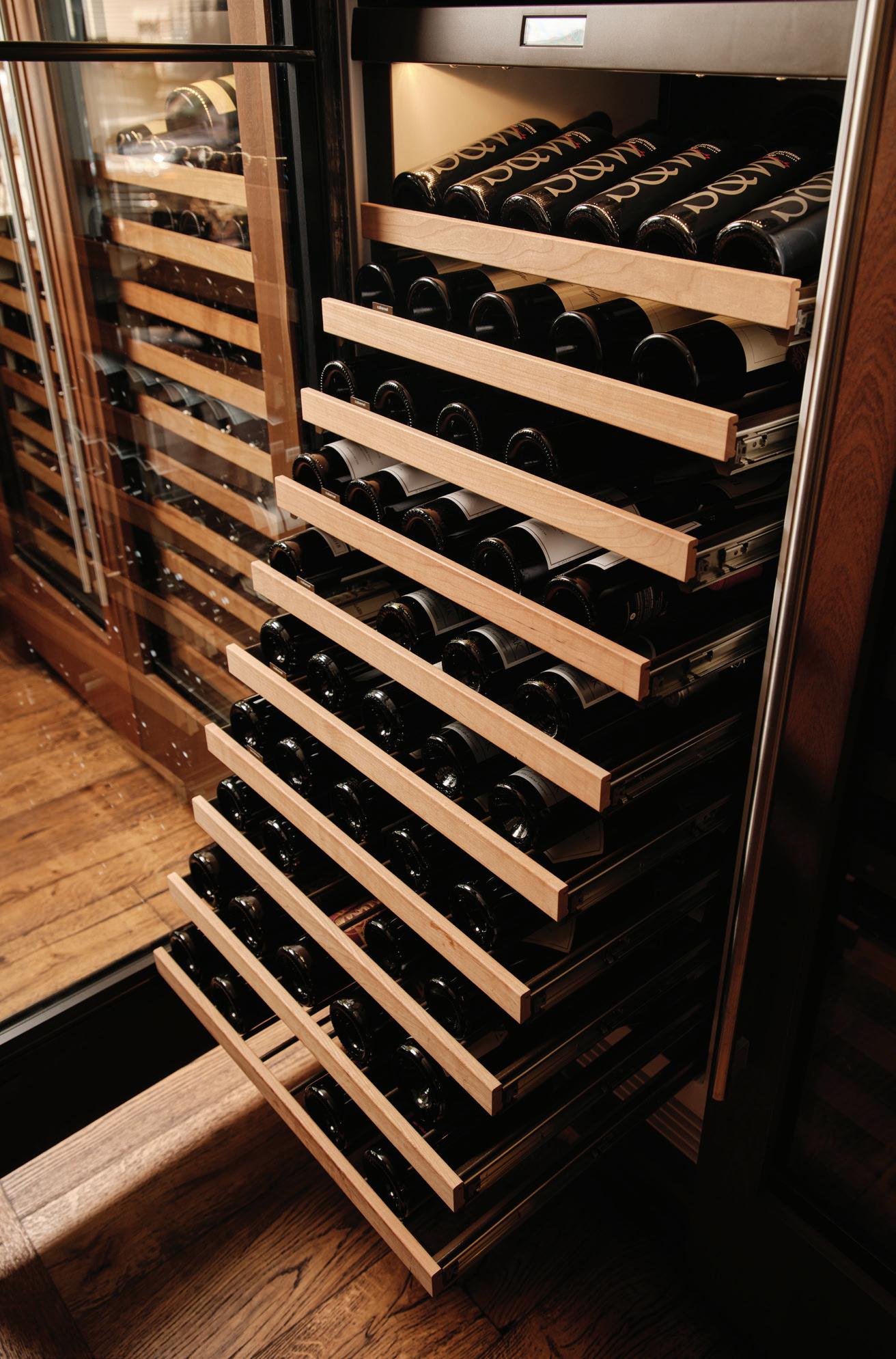
Customers have the unique experience of perusing a wine list and then glancing over to see where their wine is stored before it is opened. “When a beverage manager goes to that unit, and they open it up and pull the shelves out, everyone turns to see.” He feels this kind of engaged guest reaction to the wines on the menu improves their dining experience.
As new Smith & Wollensky locations open, the design teams consult with chefs and beverage managers to choose the correct number and models of storage units to ensure they meet the market’s needs. With both classic and designer models available in a variety of widths and bottle capacities, the SubZero wine storage line of products fulfills the needs of each discerning beverage team. “Depending on the shelving configuration, you can hold a lot of wine,” says Gianaris.
“We have guests ask to see inside, so we will show them.” He says that customers are impressed and surprised by the hundreds of bottles in each unit. “It’s not often available at other restaurants for diners to be able to take a peek inside the wine cellar, so to have these right out in a prominent position in the dining room is a special treat for wine lovers,” says Gianaris. Because these units guard against light and vibration they can be placed in the middle of a busy restaurant, and the wine is never disturbed. “Of course, the most important thing is that Sub-Zero wine storage is incredibly functional, but I think it is also quite important that they are so beautiful.”
43ISSUE 2 | THE LIVING KITCHEN
Tucked away in the Prescott National Forest, this secluded retreat is just 45 minutes North of Prescott, Arizona.

CULINARY
GETAWAY
At Arizona’s TERRA farm + manor, indulge in an adventure in gastronomy, sustainability, and wellbeing while enjoying its peacefulness and perks.
 BY JANICE RANDALL ROHLF
BY JANICE RANDALL ROHLF
***
When you imagine embarking on an exclusive food-focused adventure, Arizona may not instantly come to mind as a destination; but it should! Sur rounded by magnificent mountains on the horizon, TERRA farm + manor is a secluded 100-acre ranch tucked away in Prescott National Forest, where guests enjoy subtle rustic elegance and luxury amenities while partaking in seasonally curated farm-fresh meals and hands-on cooking courses.
This gem in the high desert is an oasis for discerning travelers seeking to relax and mingle in the tranquil Western atmosphere, but mostly to learn from culinary experts like Chef James Porter and guest instructors he selects for their expertise in food and wine. Sommelier Scott Lewis, for ex ample, regularly teaches a class in great wines and, with Chef Porter, leads a course in creative food and wine pairings inspired by the region and history of the terroir.
A typical four-day, three-night visit begins with a warm welcome and a flute of fine French Champagne, which sets the bar for the high-end experience yet to unfold. “Our motto is don’t ever say no,” says Chef Porter, a native Arizonan who helms TERRA’s culinary operations, having led the kitchens of the Arizona Biltmore along with his own pair of high-end res taurants in the state. “After the champagne, while guest luggage is whisked away to their rooms (each one named after a tree that grows in Arizona), we tour the property and explain TERRA’s regenerative practices and methods of farming.”
TERRA’s commitment to its role as stewards of the land is fundamental to its business model. Fields and three greenhouses are dedicated to grow ing the flowers, vegetables, and herbs used for decoration and cooking ingre dients. There is a two-acre orchard and a newly designed four-acre vine

TERRA is in a constant state of planting, growing, and harvesting. Opposite page: The Cookery Courtyard has a wood-burning oven, traditional and deep pit barbeques, and an open-fire cooking area. The subtle rustic elegance of TERRA’s guest lounge.

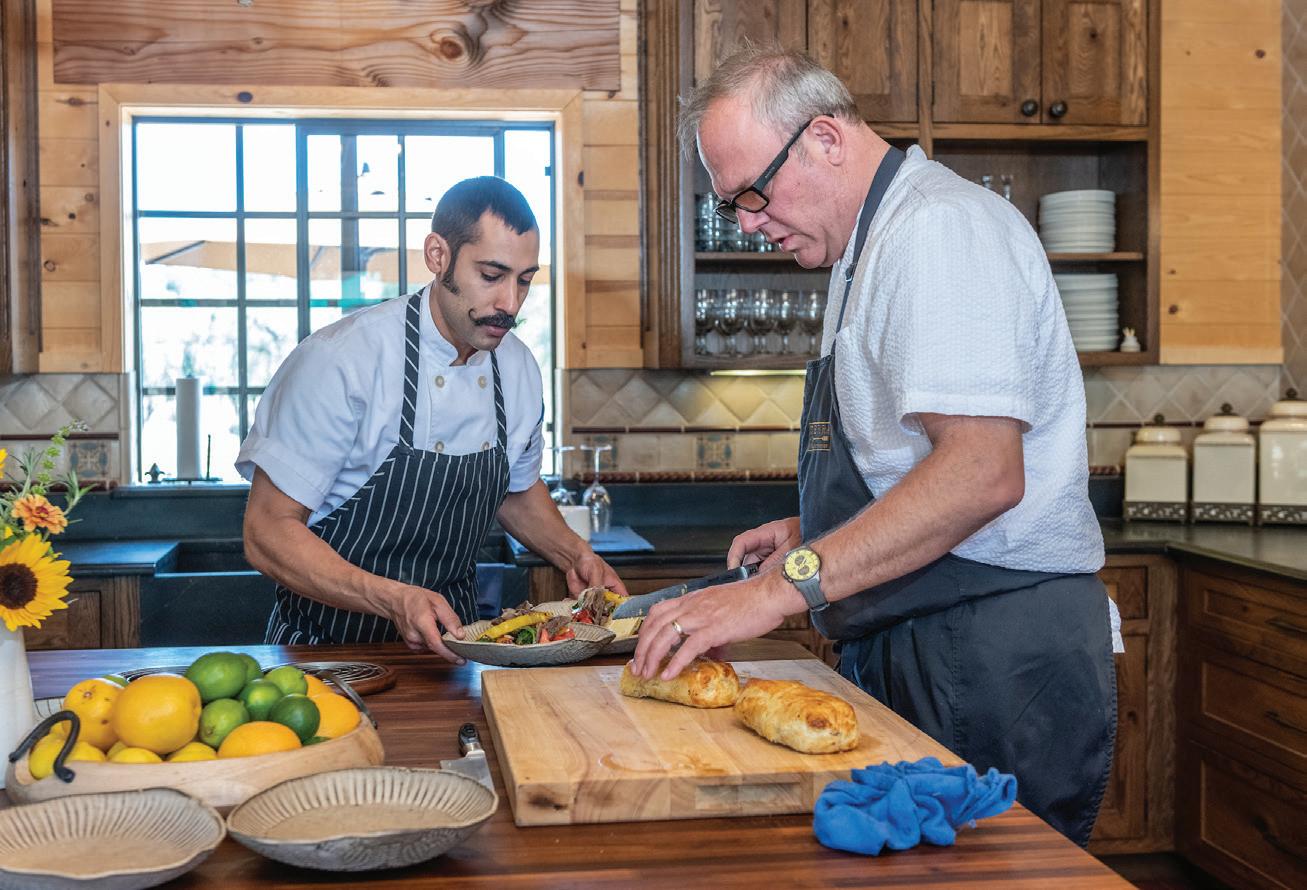
46 THE LIVING KITCHEN | ISSUE 2



47ISSUE 2 | THE LIVING KITCHEN
yard. Animals raised here through collaborations with local farmers include Japanese Wagyu cattle, Iberico pigs from Spain, and Bresse and French Black Copper Maran chickens from Europe. For guests, it’s a unique opportunity to experience the height of culinary sophistication while simultane ously enjoying the simplicity of farm life.
“When not cooking, our guests can explore the property, see the animals, get massages, go on hikes, kayak, horseback ride ... we will transport people wherever they want to go,” says Chef Porter. The number of guests is purposely limited to 12 to 16 to ensure an experience that is intimate, hands-on, detailed, and curated for each participant.


Among the themes for upcoming sessions at TERRA is “Flour Power: Pasta & Bread Baking with the Experts,” a four-day adventure in dough, and “Flavors of France,” which explores what’s often touted as the world’s finest cuisine and also demystifies time-honored French techniques.

48 THE LIVING KITCHEN | ISSUE 2
“TO ME, IT’S ABOUT WORKING WITH THE BEST. IF YOU WERE A RACE CAR DRIVER, YOU WOULD WANT TO GO OUT IN A FERRARI. WOLF IS THE FERRARI OF COOKING.”
TERRA offers an ideal location for unique corporate retreats, family gatherings, weddings, and other special occasions - or just a chance to relax and savor the moment.
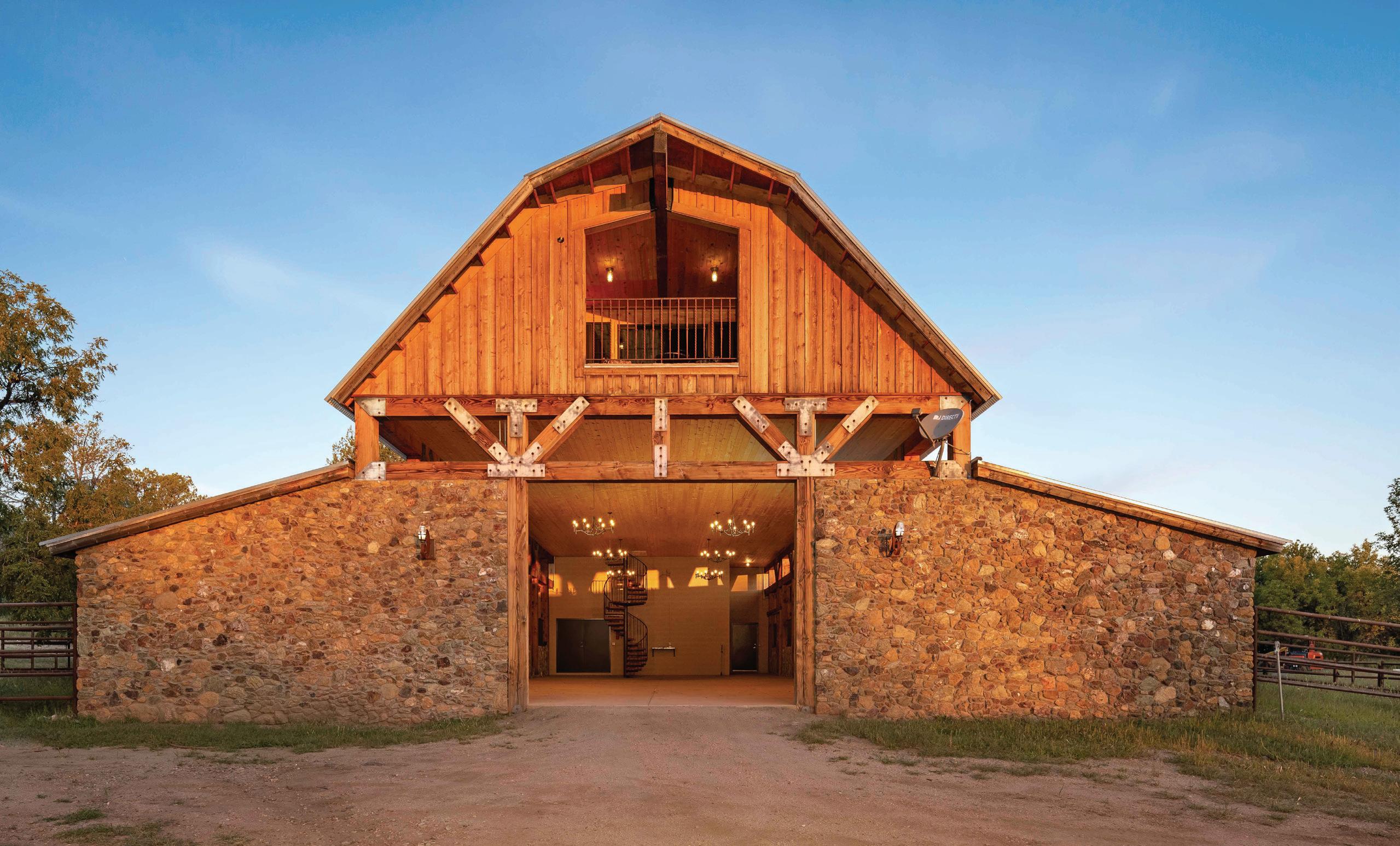
Showing his guests how to use really good ingredients correctly is his goal, says Chef Porter, adding that he focus es a lot on technique. “Everything we do here is insightful, educational, and inspirational,” he says, “but it’s not overly complicated.”
In Chef Porter’s mind, success in the kitchen comes down to an easy equation: “Take a piece of 100-percent Wagyu beef, pair it with a high-quality sauté pan and an awesome highBTU burner, and you’ll get the best meal you’ve ever had.”
In the kitchen at TERRA, Wolf ranges are the equipment of choice. Their dual-stacked, sealed gas burners deliver pow er and control for every chef. “To me, it’s about working with the best,” says Porter. “If you were a race car driver, you would want to go out in a Ferrari. Wolf is the Ferrari of cooking.”
The hyperbole that creeps into Chef Porter’s vo cabulary when he speaks of TERRA is well earned. In a constant state of planting, growing, and harvesting where second-best won’t do, TERRA is, by nature, a highly ex clusive food-focused destination. And if Chef Porter con tinues to have his way, it will always be more about a oneof-a-kind experience than a traditional luxury vacation.
Learn more at terrafarmandmanor.com

49ISSUE 2 | THE LIVING KITCHEN
By lisa cavanaugh
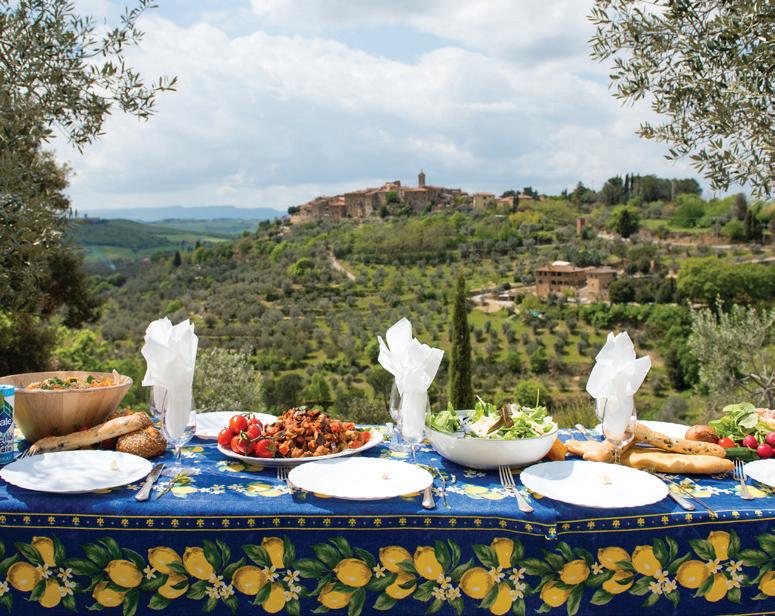


A Massachusetts-based boutique touring company gives cycling enthusiasts the opportunity to travel the world with a culinary focus.


adventures
WHEELS TWOon
Imagine a vacation where you can meander slowly through some of France’s most picturesque wine regions, enjoy a private wine tasting at a prestigious Château, join an exciting truffle hunt, and indulge your senses in culinary delights such as coq au vin, boeuf bourguignon, Jambon Persillé, and duck confit. Now imagine that you can do all this on a bike. This kind of specialty adventure is the forte of DuVine Cycling + Adventure Co., a small-group luxury bike touring company based in Cambridge, Massachusetts. “We like to say that the DuVine travel style transcends tourism,” says Mia Liefeld, DuVine’s director of marketing and communi cations, “and this is thanks in large part to our local guides and Trip Designers.”


DuVine’s fascination with, and commitment to, local character and culture has resulted in unique tours led by guides who speak the language and know the roads and regions exceptionally well. “Because they have deep roots where they guide—often where they were born or have lived for decades—they share their personal network with our guests,” says Liefeld. “It could be a picnic lunch at a family member’s winery, opening doors to the studio of an artisan in the community, or simply knowing a cycling road that’s well off the beaten path.”
Liefeld explains that DuVine trips are developed, designed, scouted, and re-assessed annually by local trip designers who live and work in the area. “They’re accus tomed to knocking on doors and making those discoveries

“To know a place, you must really experience the culinary culture firsthand— how the coffee is prepared, what fruit trees line our cycling routes, which Bordeaux wine best amplifies the flavor of Arcachon oysters.”
52 THE LIVING KITCHEN | ISSUE 2
and connections that just don’t emerge when you drop in as an outsider,” she says. “We marry must-see sites and lesser-known roads, pepper in character-rich experiences with charming personalities, and limit de partures to 14 guests so you can experience everything intimately.”
DuVine is selective in launching new itineraries because they want to ensure a high-touch, luxury experience from end to end in any new destination. This means the roads must be scenic, traffic-free, and well-maintained. Hotels have to showcase the charac ter of the area while also having exceptional amenities and service, and the region itself should have a distinc tive culinary and/or viticultural identity.
Trips such as the Tuscany Harvest Tour, the Dolo mites and Lake Garda Chef on Wheels Bike Tour, or the Hudson Valley’s Farm-to-Table Weekend Retreat speak to the gourmand who is moved by culinary experienc es like cooking classes, hands-on harvests, exclusive tastings, or one-on-one visits with winemakers. “We’re obsessed with food and wine because we believe every region is revealed through its cuisine,” says Liefeld. “To know a place, you must really experience the culinary culture firsthand—how the coffee is prepared, what fruit trees line our cycling routes, which Bordeaux wine best amplifies the flavor of Arcachon oysters.” She believes that these facets of a DuVine specialty tour will be whol ly satisfying to the appetite of a true foodie.


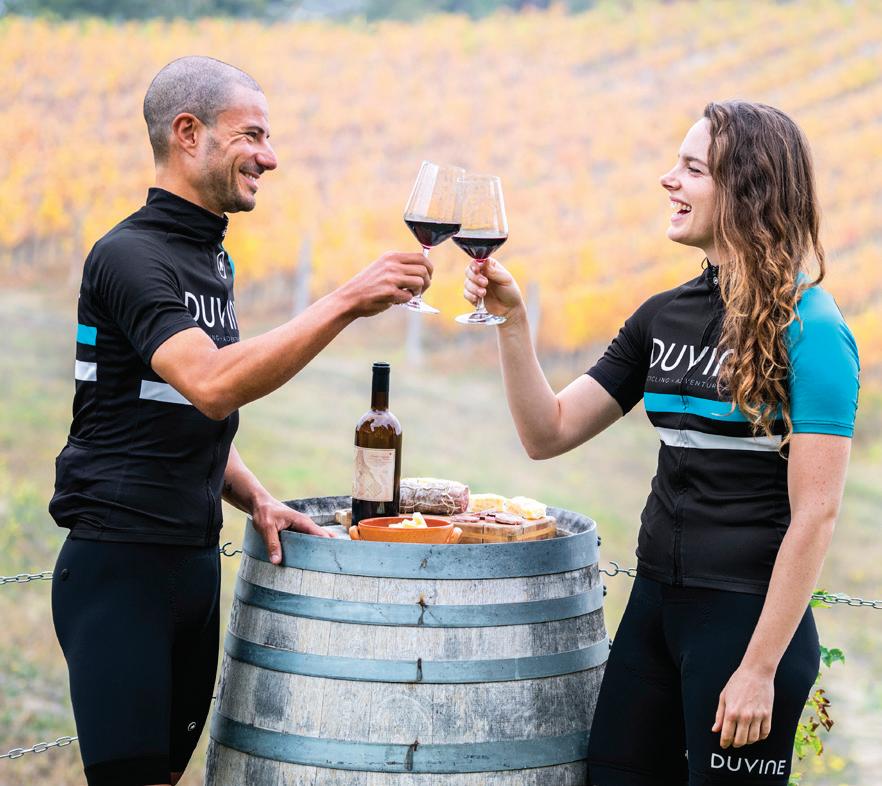
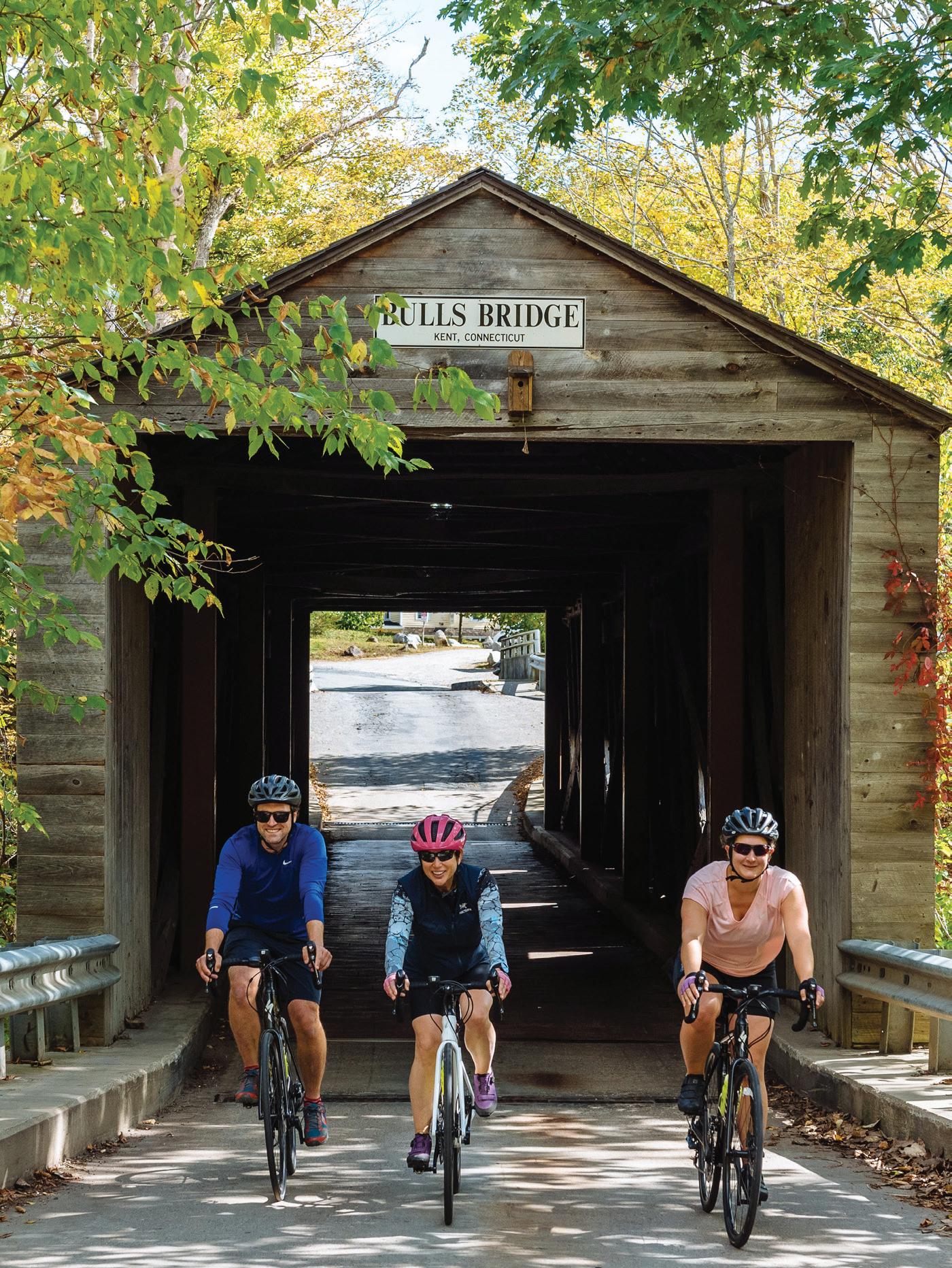

53ISSUE 2 | THE LIVING KITCHEN
DuVine tours bypass main roads in favor of going off the beaten path, opening the doors to places participants may never have found on their own.


Everything is taken care of for the cycling guest. “There’s no detail too small, no surprise too extraor dinary, and no nuance too subtle when we set the stage for your memories, “says Liefeld. The price of a DuVine bike tour includes deluxe boutique accommo dations, gourmet meals with wonderful local wines, après velo cocktails, full van support, excellent bikes, and entrance fees to historic sites. “We believe that cycling is for everyone, so our itineraries are designed to accommodate all types of riders—from cycling new comers to avid riders and everyone in between.”
There are tours at varying levels of cycling difficulty, and daily routes offer longer and shorter ride options. If you’re a dedicated cyclist, guides are happy to take you out for some extra miles. Alterna tively, less advanced riders can rely on a support van along the route or even choose electric assist cycles to quicken their pace. In addition, any scheduled tour can be made private to accommodate your own group and dates.
With journeys across the globe, in the Americas, Europe, and Africa, DuVine truly has something for everyone. Their tour collections include family-fo cused, adventure-plus, challenge-level experiences, and even cycle and sailing options.
Eco-conscious travelers can also relax knowing that DuVine takes its commitment to sustainability very seriously. “The year 2022 is the first year DuVine will be completely carbon neutral,” says Liefeld.
“We’ve always believed that bicycling is the best way to experience the world, but an essential part of celebrating and exploring the planet is to ensure it endures. We strive to set an example for a greener future and hope it inspires our peers in the travel industry to do the same.”
So if you are ready to jump on a bike, go off the beaten path, and taste the world, DuVine is ready to guide you to places you may never have found on your own.
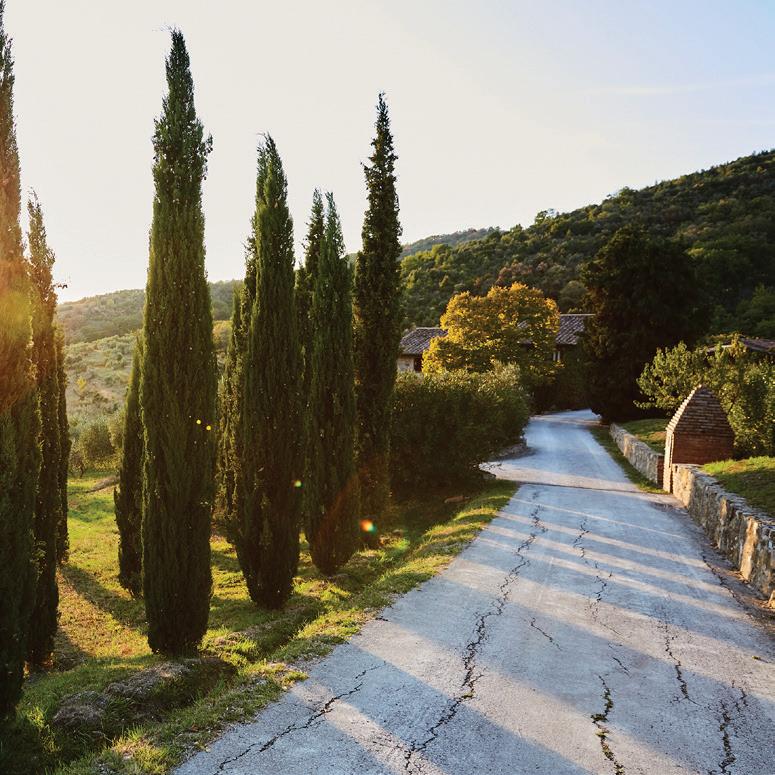
“Our bike tours are an opportunity to refresh your perception of the world, con nect with people as if you’re family or long-lost friends, and truly find your place at the table.”

55ISSUE 2 | THE LIVING KITCHEN
DuVine's specialty tours highlight all things seasonal and unique, from local farms in New England to an exploration of French winemaking.
Three Napa Valley vineyards have properties and processes that are as distinctive as their wines.

Entwined in Napa
By Marni Elyse Katz
56 THE LIVING KITCHEN | ISSUE 2
but does have a wine-buying membership program.
Note: Abreu Vineyards does not offer tours to the public
avid Abreu is a living legend in the Valley,” says Brad Grimes, the Abreu Vineyards wine maker. “He’s farmed just about every property here.” The third-generation Napa native has been planting and growing grapes at local vineyards for three decades. In the early eighties, the viticulturist acquired Madrona Ranch, the first of four of his own vineyards. In 1987, he introduced the first Abreu Vineyards wine.
Grimes joined the operation in 2000. “I’m ac tually making wine as opposed to managing a team that makes the wine, which is a rare privilege in Napa and around the world,” the Seattle chef turned winemaker says. “Once the fruit is in the door, I’m the only one to touch it.” Abreu Vineyards produces just 15,000 highly coveted bottles each year; there
Am, sit vercienis antions equam, sum dolorio nsecum imeEhenda ni que coris dit moluptati
are four single-vineyard cabernet blends and a fifth that blends grapes from all four vineyards. “I am completely immersed in the process of making truly noble, transcendent wines,” Grimes says.
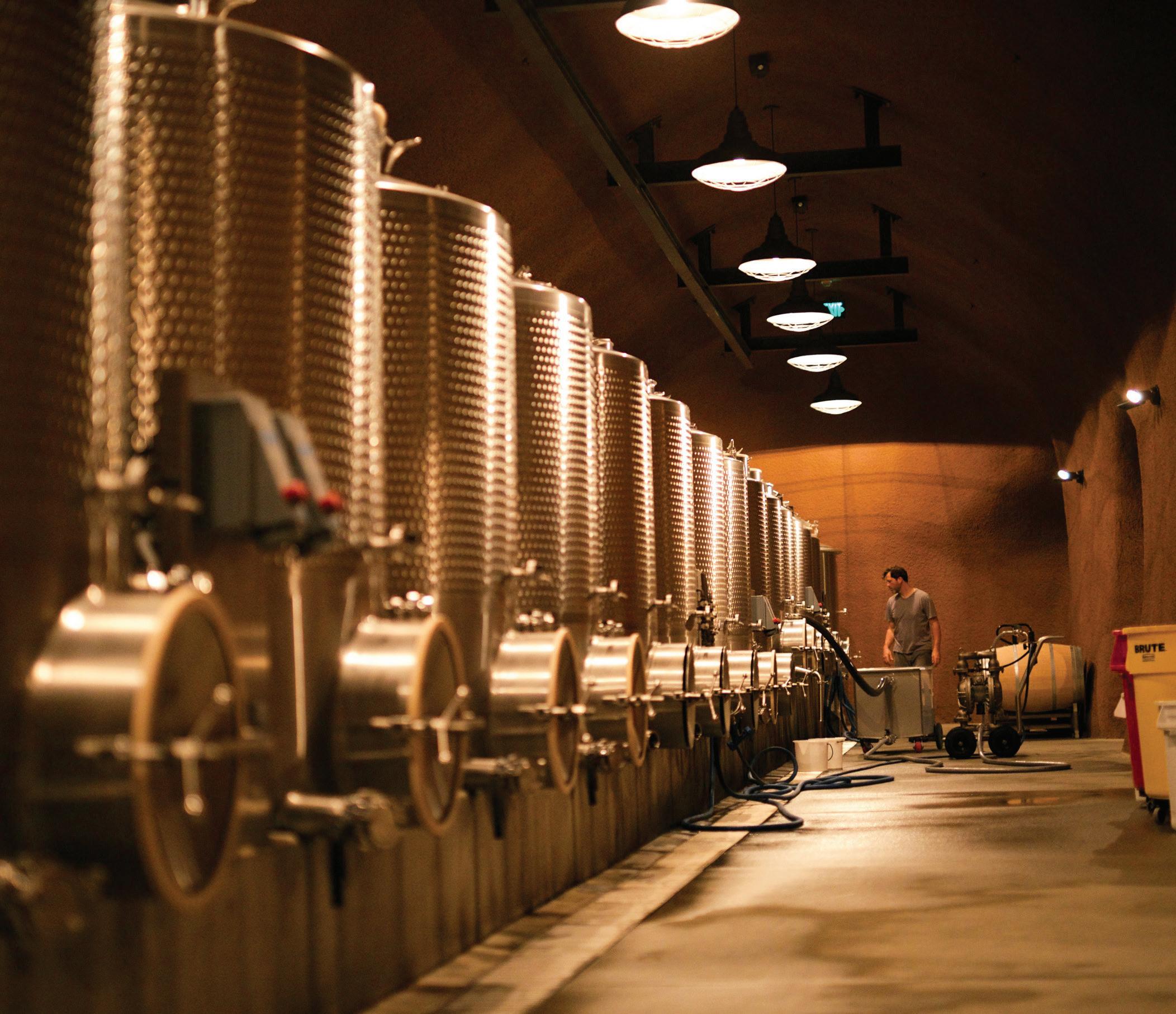
While Grimes reveres the land, the fruit, the pro cess, and the wine, he eschews the stilted language surrounding wine culture and intimidates novices. He feels there need not be tasting notes that wax poetic about tobacco, pomegranate, and figs. If a person thinks that a wine tastes like Flintstones vitamins or smells like Fun Dip, then that’s okay, he insists. “Right now, I’m sitting on the beach drinking beer brewed with raspberries,” he says. “It’s about enjoying the day drinking what tastes good to me, not about devising a tasting note.”
abreuvineyards.com
Abreu Vineyards winemaker Brad Grimes outside the winery cave.
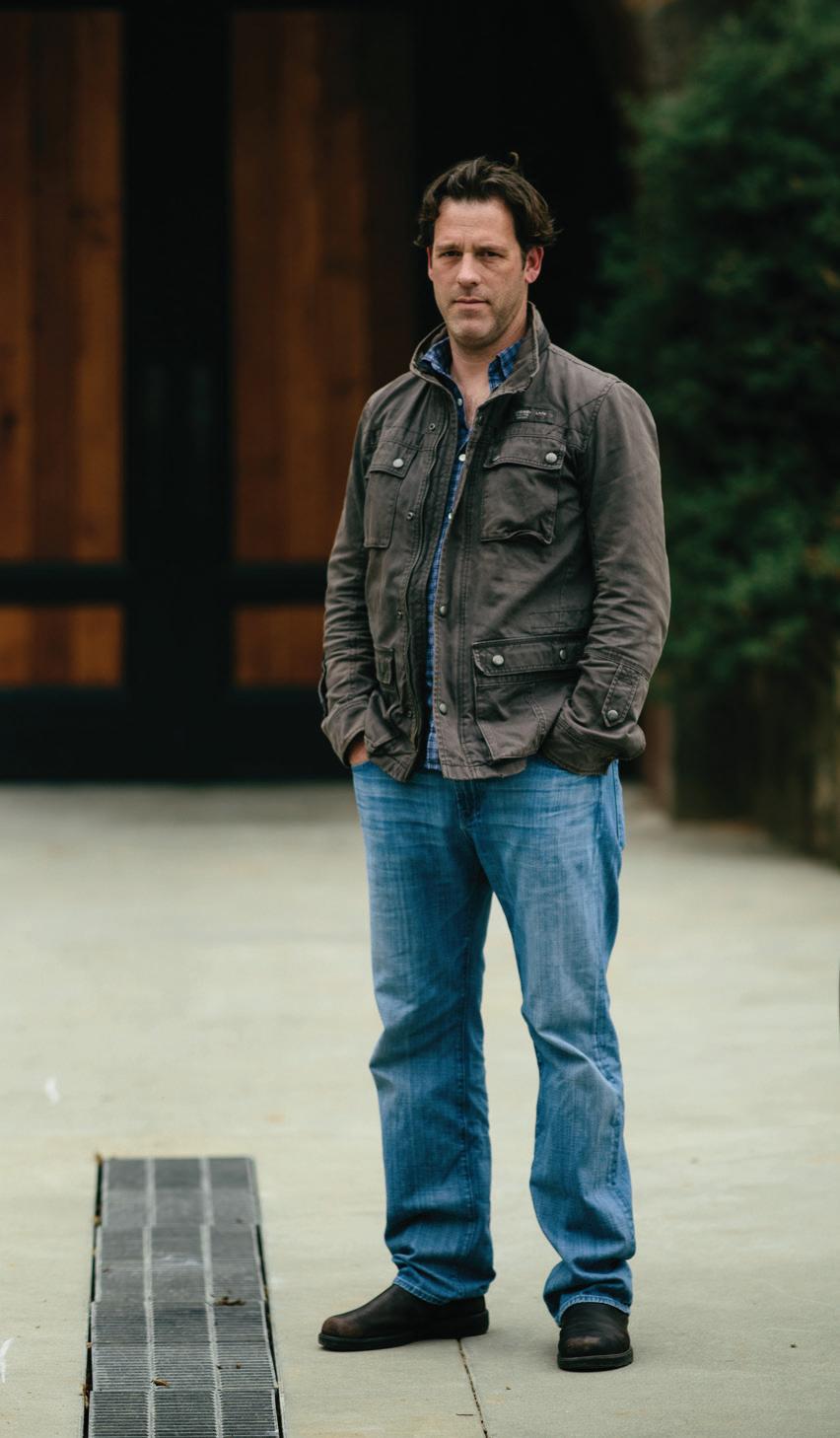
57ISSUE 2 | THE LIVING KITCHEN
While family is her focus, golf legend Annika Sorenstam finds time to give back through the game that made her famous.
“D
hen Annika Sorenstam retired from com petitive golf in 2008, she didn’t plan on ever returning to the sport. Sorenstam, one of the most decorated golfers of all time who won 72 times on the Ladies PGA Tour and is a threetime U.S. Women’s Open champion, had other things to fo cus on. She wanted to spend more time with her husband, Mike McGee, and be a hands-on mom to their daughter, Ava, and son, Will.
Yet golf has remained a part of her life in meaningful ways. “I am very thankful for where golf has taken me,” says Sorenstam, who lives in Orlando with her family. “Be fore I retired, I started to think about what I could do to give back to the game and inspire other young girls around the world to play.” In 2006, she launched the ANNIKA Foundation to help girls excel at the sport and connect with opportunities to further their progress.
TWypically, grapes are sorted and crushed outdoors on a concrete or stone slab called a crush pad. At Palmaz Vineyards in Napa, that process, and every subsequent step, happens underground. When Julio and Amalia Palmaz established this 600-acre family-run estate on the site of a historic pre-prohibition winery in the late 1990s, they built the entire operation into the side of Mt. George. Using a gravity flow winemaking process, the grapes travel down four levels of the 18-story subterranean cave over a period of three years. “Grapes are sorted on the top level, cascade to tanks where they ferment, then flow to barrels where they age, and finally flow to the bottom level bottling line and storage area,” says Florencia Palmaz, the chief executive officer and the founders’ daughter.
“If you’re gentle to the wine, it rewards you,” she says, noting that eliminating mechanical pumps from the process minimizes damage to the fruit and thus the wine.
Originally from La Plata Argentina, Florencia Palmaz relocated to Napa Valley in 2003 to help run the family vineyard and estate.


Through the ANNIKA Foundation, the first ANNI

58 THE LIVING KITCHEN | ISSUE 2
The vineyard produces primarily cabernet sauvignon. All their grapes are grown on the prop erty’s 64 acres of vineyards, which are planted at three different elevations. Tours guide visitors through all four levels of The Cave onto the hill side to see the crops and to the library for tastings that are paired with culinary offerings utilizing fruits and vegetables grown in their gardens. “It’s a one-on-one experience,” Palmaz says, “in which you can get the whole story.”



59ISSUE 2 | THE LIVING KITCHEN
palmazvineyards.com
hen Annika Sorenstam retired from com petitive golf in 2008, she didn’t plan on ever returning to the sport. Sorenstam, one of the most decorated golfers of all time who won 72 times on the Ladies PGA Tour and is a threetime U.S. Women’s Open champion, had other things to fo cus on. She wanted to spend more time with her husband, Mike McGee, and be a hands-on mom to their daughter, Ava, and son, Will.
DWirt isn’t just dirt in wine country. The Rudd Estate, located in the heart of Oakville, has rich, red volcanic soil. “You can see the color of our soil when driving down Silverado Trail,” Wendi Green, the Rudd Estate marketing director, says. The volcanic rock is part of the family-run estate’s wines in more ways than one. When Leslie and Susan Rudd purchased the 56 acres in 1996, they expanded the existing caves, using rocks pulled from the vineyards for the stone walls around the property’s perimeter. Pulverized rocks were also incorporated into the winery’s custom concrete tanks. “The land is always part of the process,” Green notes. z Today, the couple’s daughter, Samantha Rudd,
Yet golf has remained a part of her life in meaningful ways. “I am very thankful for where golf has taken me,” says Sorenstam, who lives in Orlando with her family. “Be fore I retired, I started to think about what I could do to give back to the game and inspire other young girls around the world to play.” In 2006, she launched the ANNIKA Foundation to help girls excel at the sport and connect with opportunities to further their progress.
Through the ANNIKA Foundation, the first ANNI
Vintner Samantha Rudd believes that great wine will always be a reflection of its place.



60 THE LIVING KITCHEN | ISSUE 2
is in charge of the flourishing vineyard, which produces predominantly cabernet sauvignon. The land is farmed organically and biodynamically by a dedicated in-house team. “Each crew member cares for his or her own row of vines from start to finish, year after year,” Green says.


“It’s that attention to detail that sets us apart.” Guest vis its begin in the vineyards, continue through the extensive California-inspired gardens, into the estate’s winemak ing workshop, and end with an outdoor tasting overlook ing the lake. If you come during the winter season, you can catch a glimpse of the dozen-plus sheep that eat the cover crop and naturally fertilize the land. “There’s a wonderful energy here,” Green says. “You feel like you’re visiting the family’s home.”

61ISSUE 2 | THE LIVING KITCHEN
ruddwines.com
In the

swing things of
When Annika Sorenstam retired from competitive golf in 2008, she didn’t plan on ever returning to the sport. Soren stam, one of the most decorated golfers of all time—she won 72 times on the Ladies PGA Tour and is a three-time U.S. Women’s Open champion—had other things to focus on. Primarily, she wanted to be a hands-on mom to her daughter, Ava, and son, Will, and spend more time with her husband, Mike McGee.
Yet, golf would remain a part of her life in meaningful ways. “I am very thankful for where golf has taken me,” says Sorenstam, who lives in Orlan do with her family. “Before I retired, I started to think about what I could do to give back to the game and inspire other young girls around the world to play.” In 2006, she launched the ANNIKA Foundation to help girls excel at the sport and connect with opportunities to further their progress.
By Jaci conry • Photography by dan cutrona
While family is her focus, golf legend Annika Sorenstam finds time to give back through the game that made her famous.

Annika Sorenstam is passionate about sharing the game she loves with young women
When Annika Sorenstam retired from com petitive golf in 2008, she didn’t plan on ever returning to the sport. Sorenstam, one of the most decorated golfers of all time who won 72 times on the Ladies PGA Tour and is a threetime U.S. Women’s Open champion, had other things to fo cus on. She wanted to spend more time with her husband, Mike McGee, and be a hands-on mom to their daughter, Ava, and son, Will.
Yet golf has remained a part of her life in meaningful ways. “I am very thankful for where golf has taken me,” says Sorenstam, who lives in Orlando with her family. “Be fore I retired, I started to think about what I could do to give back to the game and inspire other young girls around the world to play.” In 2006, she launched the ANNIKA Foundation to help girls excel at the sport and connect with opportunities to further their progress.
Through the ANNIKA Foundation, the first ANNI KA Invitational was held in 2007. It was a triumph, by all accounts. “We had more than 70 girls representing 20 countries play in the Invitational,” recalls Sorenstam. Since that successful launch, she has hosted annual three-day tournaments in the United States and her native Sweden for players ages 12 to 16. College coaches attend the tourna ments to scout for players, and many girls get discovered there and are provided a chance to play at the college level.
Sorenstam’s commitment to developing women’s golf worldwide and encouraging children to lead healthy, active lifestyles also led the ANNIKA Foundation to create Share My Passion. This inspirational program invites girls ages 6 to 12 living in the U.S. to write a letter or submit a video tell ing other girls their age why they love the game of golf. From the hundreds of entries submitted, the 40 finalists with the most compelling pieces are chosen by Sorenstam and her committee to attend a day clinic led by Sorenstam at no cost. “Most of the girls who come to clinics have played some golf before,” she says. “The clinic’s purpose is to have the girls meet other girls who share their interest in golf.”
Developing women’s and girls’ interest in her life-long passion is a big part of why she is back on the links. “When I started doing this 14 years ago, only 17 percent of the junior golf players in the country were female, and now that number is up to 35 percent. I feel really good about that,” says Sorenstam, pointing out that her goal isn’t to help create the next female golf superstars but rather to educate young women and give them access to the sport, which could help them succeed in the future. “Golf is a game for
life. In business, many deals are made on the golf course,” she adds. “Ninety percent of women in C-Suite professions have a sports background.”
When she isn’t working on her foundation, Sorenstam en joys bringing her kids to school and to their various activities. She also finds time to prepare the family’s evening meal in her spacious, contemporary kitchen. She loves to cook and has long made it a part of her life.
“Growing up in Sweden, we never went out. My mom, who learned to cook from her grandmother, made everything from scratch. I enjoyed being in the kitchen with her,” says Sorens tam. “Years ago, when I would go on tour, I’d stay with families

64 THE LIVING KITCHEN | ISSUE 2
and cook with them as a way of connecting.” When she’d return home from touring, the last thing she wanted to do was go out. “I’d cook when I got back; it was a way to relax, therapy almost. I’d read recipes and watch the Food Network,” she recalls.
When the Hall of Famer and McGee began dating, she cooked for him; the first meal she prepared for her future husband was a Bolognese, which has become a family favor ite. “Now, with the kids, we eat at home most of the time. We invite other families over for dinner often,” says Sorenstam. “I also love to make breakfast—pancakes, smoothies—meals are our time to be together as a family.”
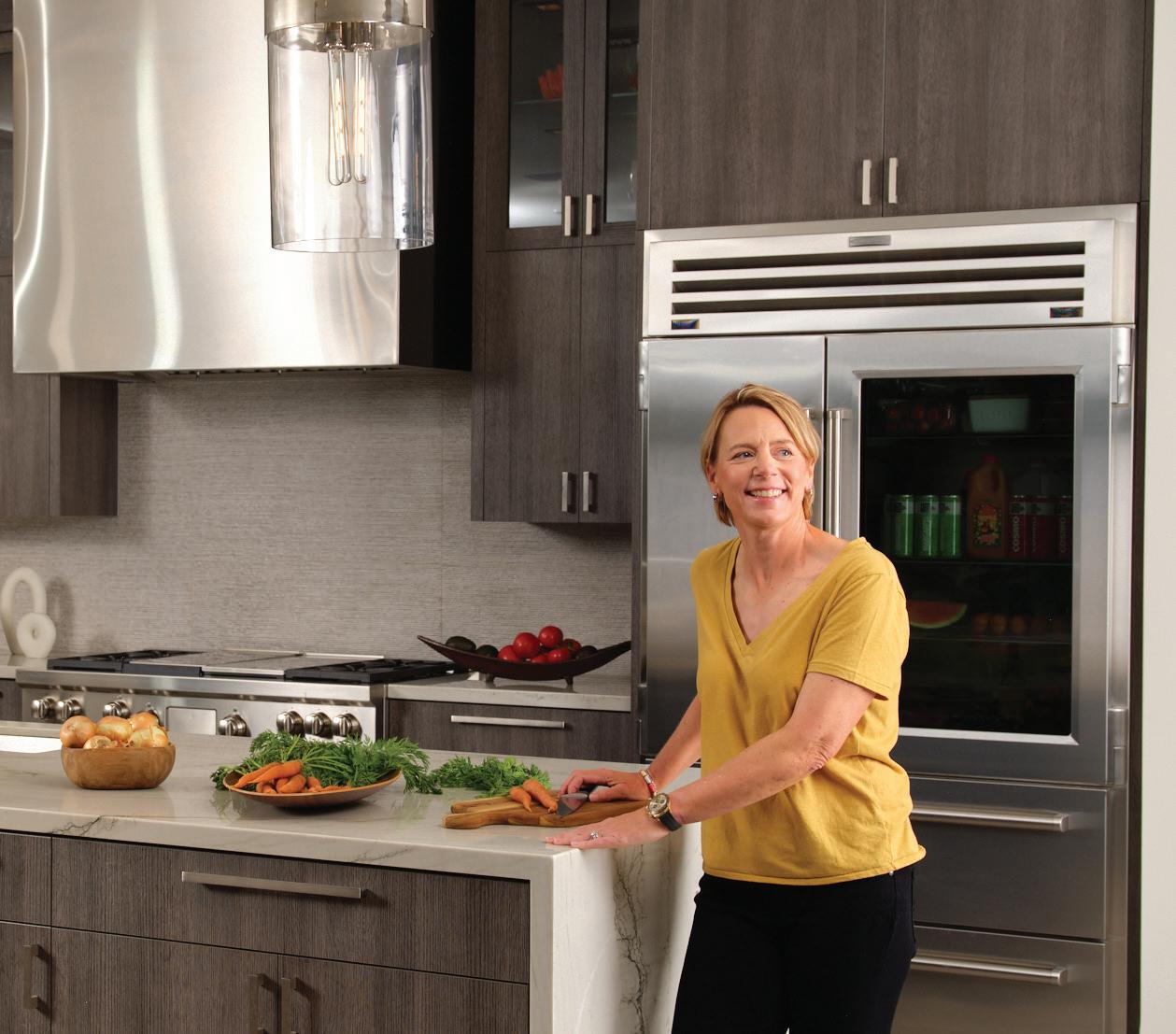
During Covid, when Sorenstam’s son started playing
golf more seriously, she found herself out on the course with him quite a bit. She discovered that she really enjoyed being back on the links and went on to play in a few local tourna ments over the next year. “I realized I was a little rusty, so I started playing even more,” she says. In 2021, Sorenstam won the U.S. Senior Women’s Open at Brooklawn Country Club in Fairfield, Connecticut, which qualified her to play in the U.S. Women’s Open this past summer. Her involvement deepened, and now, she will be the tournament host of an annual LPGA event. Taking place at the Pelican Golf Club in Belleair, Florida, the tournament will be called The Anni ka driven by Gainbridge at Pelican. She says she is excited to
65ISSUE 2 | THE LIVING KITCHEN
Sorenstam, seen here in the kitchen of her Orlando, Florida home, enjoys cooking for her family of four.
BY LISA CAVANAUGH
With his restaurant menus, Garces honors his Ecuadorian background.
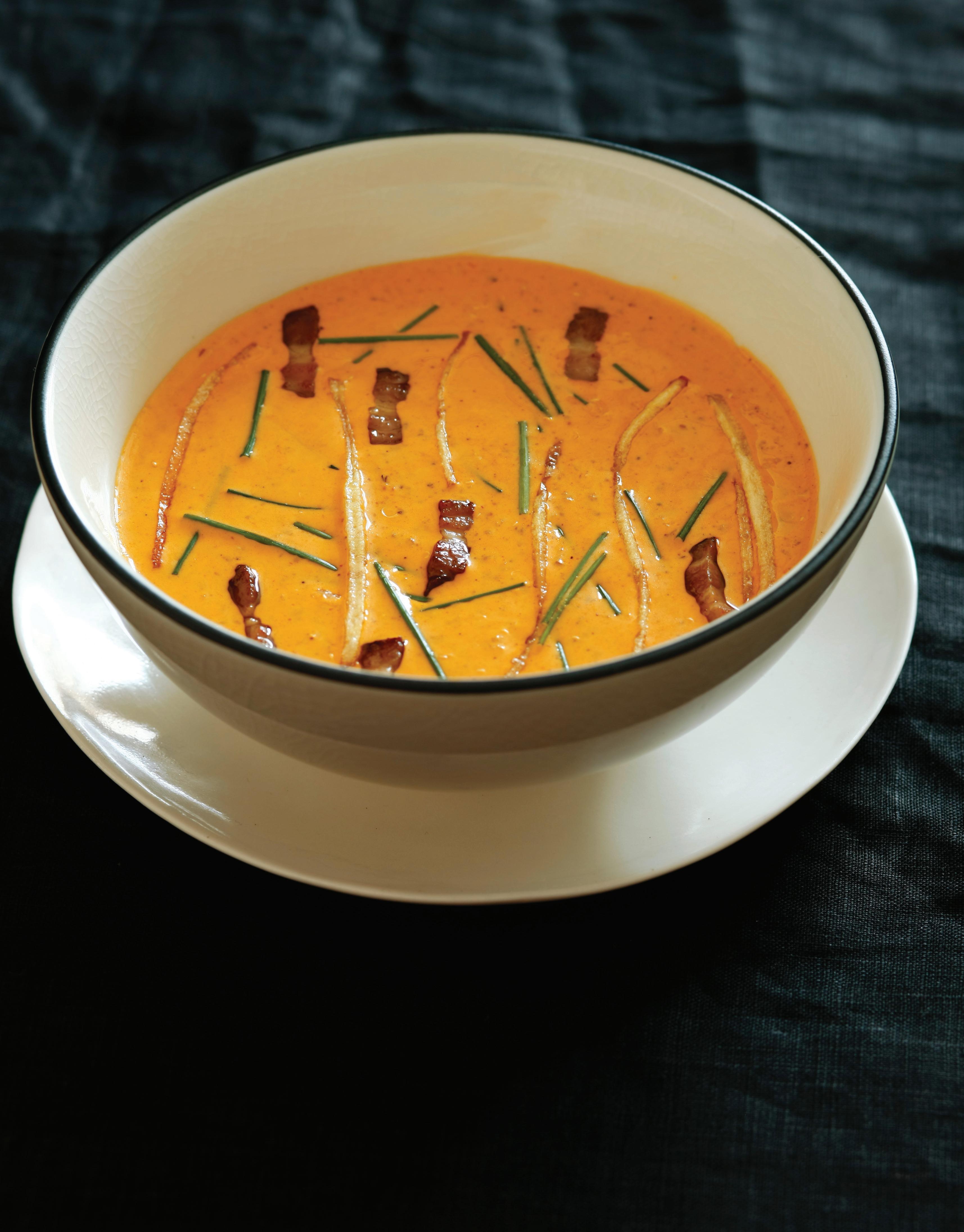
FLAVOR
Growing up in Chicago as the child of Ecuadorian immigrants, Jose Garces says that food was always a huge part of his life. “I remember being side by side with my Mamita, Amada, turning out empanadas for family events, but also going to the Mexican markets with my dad, and still loving the particular items that are unique to Chicago, like our pizzas, hot Italian beef, and hot dogs,” says Garces, an awardwinning chef, restaurateur, and former Next Iron Chef champion.

“As a child in America, you yearn to be accepted as American, but for me, the pull of the culture and food of my ancestral homeland has always had a place in my heart.”
At his restaurants in New York, New Jersey, and his adopted home of Philadelphia, Garces regularly serves versions of his favorite Ecuadorian dishes. “Empanadas de Verde, biche de camaron, a shrimp and seafood stew made from plantains, and fritada, which is a crispy pork served with hominy salad; I’ve made variations on all of these items throughout my career on various menus,” he says.
Garces says his culinary style is heavily influenced by both his classical training in French techniques and cookery, as well as his travels. “I spent a few years out of culinary school working in Spain and picked up so many small twists from cooks there that I’ve added to my
FUSION
An award-winning chef stays true to his Latin American heritage and shares his culinary culture.
repertoire.” He says his adventures in Peru, Ecuador, Mexico, and Japan have exposed him to new foods, techniques, and concepts. “I feel like everything I do is filtered through the depth and breadth of my experiences, so while something may be primarily Latin-inspired, you may see a French technique or a Japanese presentation floating around.”
His passion extends beyond the kitchen to his non-profit organization, the Garces Foundation. “For the past ten years, we have been actively involved in providing much-needed support for the immigrant community in Philadelphia,” he says. “From medical clinics, dental care, and access to education and food resources, we’ve been able to make tangible impacts in the lives of our community members.”
Garces is also deeply involved in a chef residency program at Volvér, his restaurant at the Kimmel Center for The Performing Arts in Center City, Philadelphia. “We are currently in the process of vetting potential chefs for our second cohort,” he says. “It’s been really exciting to get to work with this variety of talented chefs and give them a platform to reach a different market.”
Seizing opportunities is a concept familiar to the winning contestant on the fiercely competitive Iron Chef. “I’d actually

tried out for the previous season of Next Iron Chef but wasn’t selected at the time,” he says. “After appearing on the regular season of Iron Chef as a contestant and beating Bobby Flay, I was invited to compete in the second season of NIC. It was a lot of fun, but it was also hard to be away from home.”
Despite the time apart from family, he appreciated having the amazing experience of cooking in Tokyo for the finale and the pleasure of being one of the few culinarians to reach the title of Iron Chef. However, he finds even more value in the recognition granted via the James Beard award. “While becoming an Iron Chef certainly increased my visibility to the masses, winning a James Beard Award was special because it is awarded by your peers,” he says. “Knowing that I had garnered that level of recognition for my work was amazing and humbling.”
Recently he has reflected on what he loves the most about his work. “I started thinking about what the ‘sweet spot’ is in all that I do,” he says. “For me, it is practicing my craft at a high level, with the best-sourced ingredients I can get my hands on, and cooking for people who really appreciate the art. That experience of cooking, serving, and letting others enjoy, is where I’m happiest.”
68 THE LIVING KITCHEN | ISSUE 2
Garces stays busy overseeing several East Coast restaurants, a culinary-focused foundation, and a chef residency program in Philadelphia.

Crema de Quinoa de Zuleta
MAKES: 9 buns
INGREDIENTS
Quinoa Chowder:
Fresh corn is always the best choice, but may not be in season when you find yourself most in need of this kind of creamy, comforting sustenance—frozen corn is fine in a pinch.
2 cups vegetable oil
1 small Idaho potato, peeled and cut into thin strips
Kosher salt
2 Tbsp unsalted butter
1 Tbsp extra virgin olive oil
1/2 Spanish onion, [cut into long thin strips?](1/2 cup)
2 Tbsp minced garlic (6 to 8 cloves)
1 Tbsp achiote paste (page 000) [xref specialty ingred source guide]
1 1/2 cups quinoa, any color
2 ears fresh white sweet corn, kernels cut off the cob (1 cup)
5 cups vegetable stock (page 000) [xref basic recipe]
1 cup heavy cream
2 Tbsp minced fresh Italian parsley
2 Tbsp minced fresh chives
4 oz chopped, cooked bacon
Ecuadorian Chile Sauce, for serving (page 000)
Sliced avocado, for serving
PREPARATION METHOD
1. Line a baking sheet with parchment paper.
2. To fry the potatoes, heat the oil in a Dutch oven over medium heat until it reaches 375°F. Add the
3. potatoes in batches, turning in the oil until golden brown and very crispy on all sides, 1 to 2 minutes per batch. Remove the fried potatoes to the lined baking sheet to drain and cool. Season to taste with salt.
4. Heat the butter and olive oil in a medium soup pot over medium heat and cook the onion and garlic,
5. stirring occasionally, until translucent, about 10 minutes. Stir in the achiote paste and cook the mixture for another 5 minutes.
6. Stir in the quinoa and corn and cook, stirring often, until the grain is lightly toasted, about 5 minutes.
7. Add the vegetable stock and the heavy cream and bring to a boil. Reduce the heat to a simmer, medium-low heat, and cook the chowder uncovered until the grain is very tender and the liquid is reduced by a quarter, about 45 minutes. Fold in the parsley, chives, bacon, and fried potatoes and season the quinoa to taste with salt. Garnish with the avocado.
69ISSUE 2 | THE LIVING KITCHEN
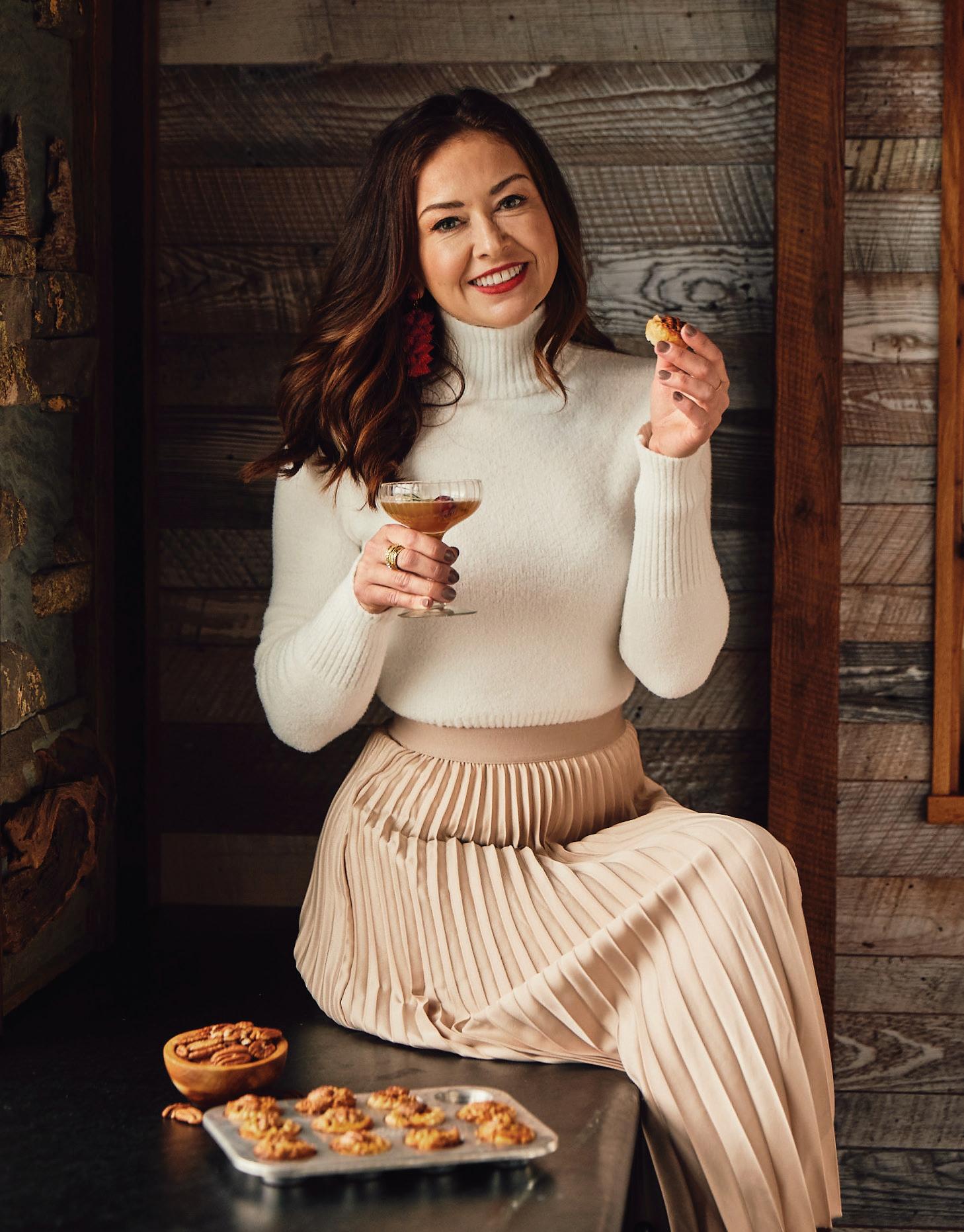 PHOTO BY GIEVES ANDERSON
Executive Chef Brandie Lamb enjoys creating intriguing seasonal menus, with everything from cocktails to desserts.
PHOTO BY GIEVES ANDERSON
Executive Chef Brandie Lamb enjoys creating intriguing seasonal menus, with everything from cocktails to desserts.
Inspired by her Southern upbringing, Executive Chef Brandie Lamb tends to her lovable animals and freshly grown vegetables from her own slice of heaven in central Tennessee.
Georgia native Brandie Lamb, an executive chef with Tisdel Distributing, the exclusive distributor of Sub-Zero, Wolf, and Cove in the Midwest and Mid-South, has been as busy this year on her Tennessee farm as she has been in the kitchen. “I was living on a property closer to Nashville when I ended up purchasing an old log cabin on 22 acres in Columbia,” says Lamb. “And it has been an exciting process so far getting it up and running.”
An avowed animal lover, Lamb, has a veritable menagerie of goats and sheep ready to move onto

her property once she finishes her renovations. “Right now, I just have some chickens, a couple of roosters, and my dogs and cat here, but soon I will have a full-fledged hobby farm.”
Lamb found what she considers “the prettiest place of all” by way of Florida and Missouri. “I just love Middle Tennessee,” she says. “I’ve been here for going on three years now, and before that, I was in St. Louis for nine years.” There, she worked both as the owner of Nosh Catering and then as executive chef at another Sub-Zero, Wolf, Cove showroom before transitioning to Tisdel, which is based in Cincinnati.
71ISSUE 1 | THE LIVING KITCHEN
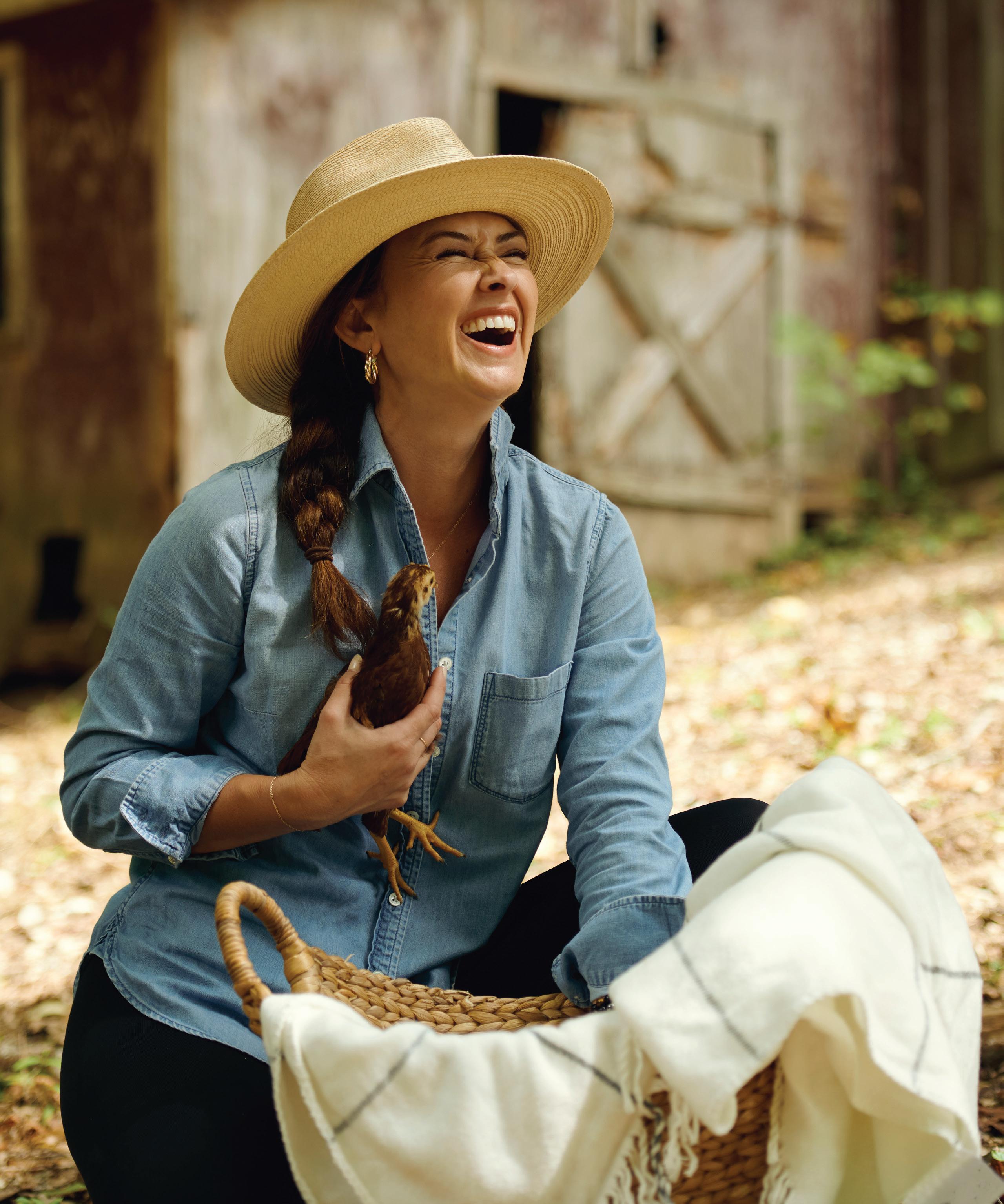
72 THE LIVING KITCHEN | ISSUE 1
PHOTO BY JASON MYERS
Despite having a few different states on her resume, her Georgia roots shine through in her cooking. “Georgia is known for its pecan trees, so my mom and grandmother and I would make these delicious little mini tarts for the holidays,” says Lamb.” My family calls them pecan tassies, and we’d have them every year." Lamb says she was able to re-create them perfectly using the Wolf Convection Steam Oven. “These ovens have so many different capabilities,” she says, detailing how she provides customer use and care instructions. “I help make sure they know all the ways owners can use their new appliances,” she says. “I always love to see the light bulb going off during my demonstrations! It gives them a better result when they understand these great functions.”
While she may not grow her own pecans on her Tennessee farm, Lamb is looking forward to planting other trees. “I grew up with fruit trees, but I've never had them personally, so I'm going to try to do that.” She has already plotted out where her new garden is going. “I’ve always had a garden,” says Lamb. “I grow all kinds of lettuces, specific tomato varieties, and lots of herbs. I’m really big on using herbs in all of my recipes.” She describes with delight being able to pluck fresh herbs right from her front porch. “ I have a lot of turkey and deer in my yard, so I'll sit out there and watch them in the morning with my breakfast. I can lean over, get mint from my mint bush, and put it right in my yogurt and fruit.”
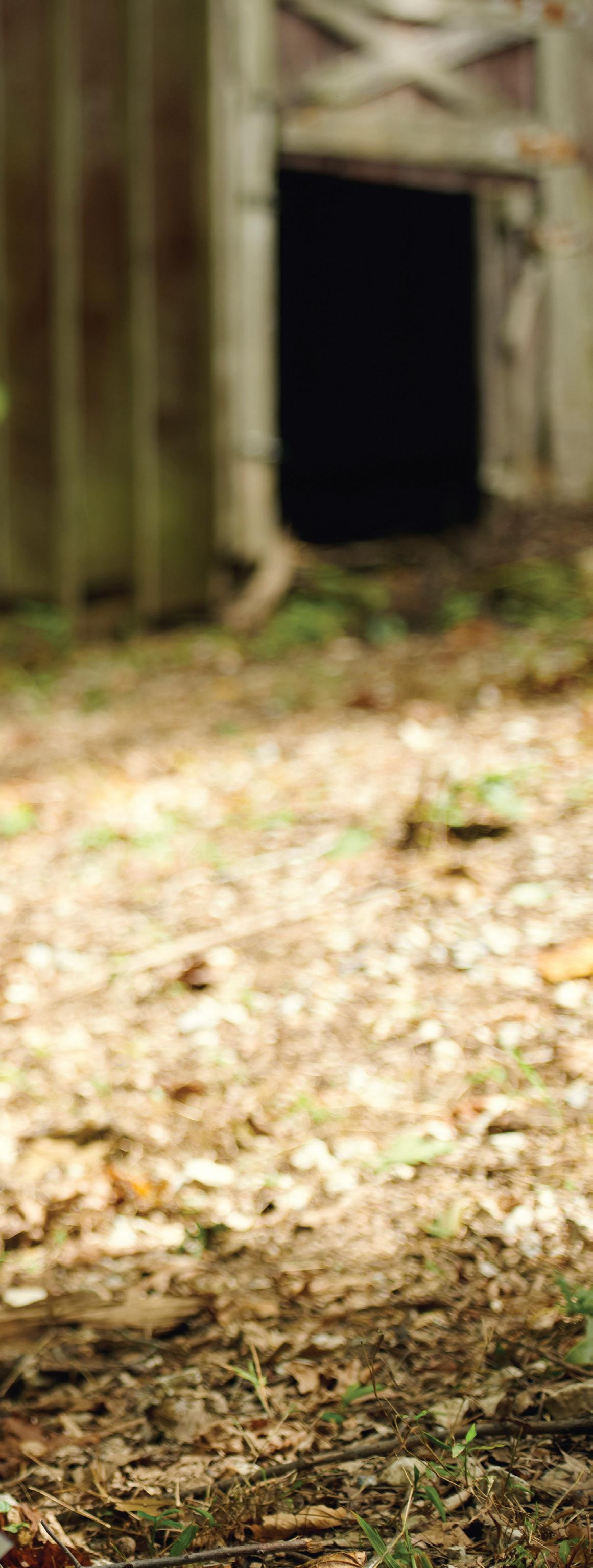
A key part of her culinary style is the ability to incorporate her homegrown produce. “I think it's really important to be able to pull vegetables, fruits, and herbs from your yard and add them directly into your cooking,” says Lamb. “Being able to grow things that don't have chemicals on them, store them in Sub-Zero refrigerators, and know that they will stay fresh is amazing.”
Every Sub-Zero has a digitally precise microprocessor that keeps temperatures consistent and an air purifier that cleans the interior air and extends the life of refrigerated foods.
That Sub-Zero assurance of freshness comes in handy for Lamb’s famous unconventional salads. ”I get very bored with just a bowl of greens and tomatoes,” she says, “so I have created a huge collection of ‘not-salads’ that have a ton of different, interesting components, like toasted hazelnuts, crispy shallots, and roasted butternut squash.” She finds it easy to incorporate seasonal ingredients and loves using blackberries and toasted cornbread croutons in the fall and sweet grilled corn and juicy peaches with a basil dressing for a bright summer dish. “It makes it lots of fun to eat healthfully!”
73ISSUE 1 | THE LIVING KITCHEN
Chef Brandie cuddles one of her chickens on her farm in Central Tennessee.
Pecan Tassies
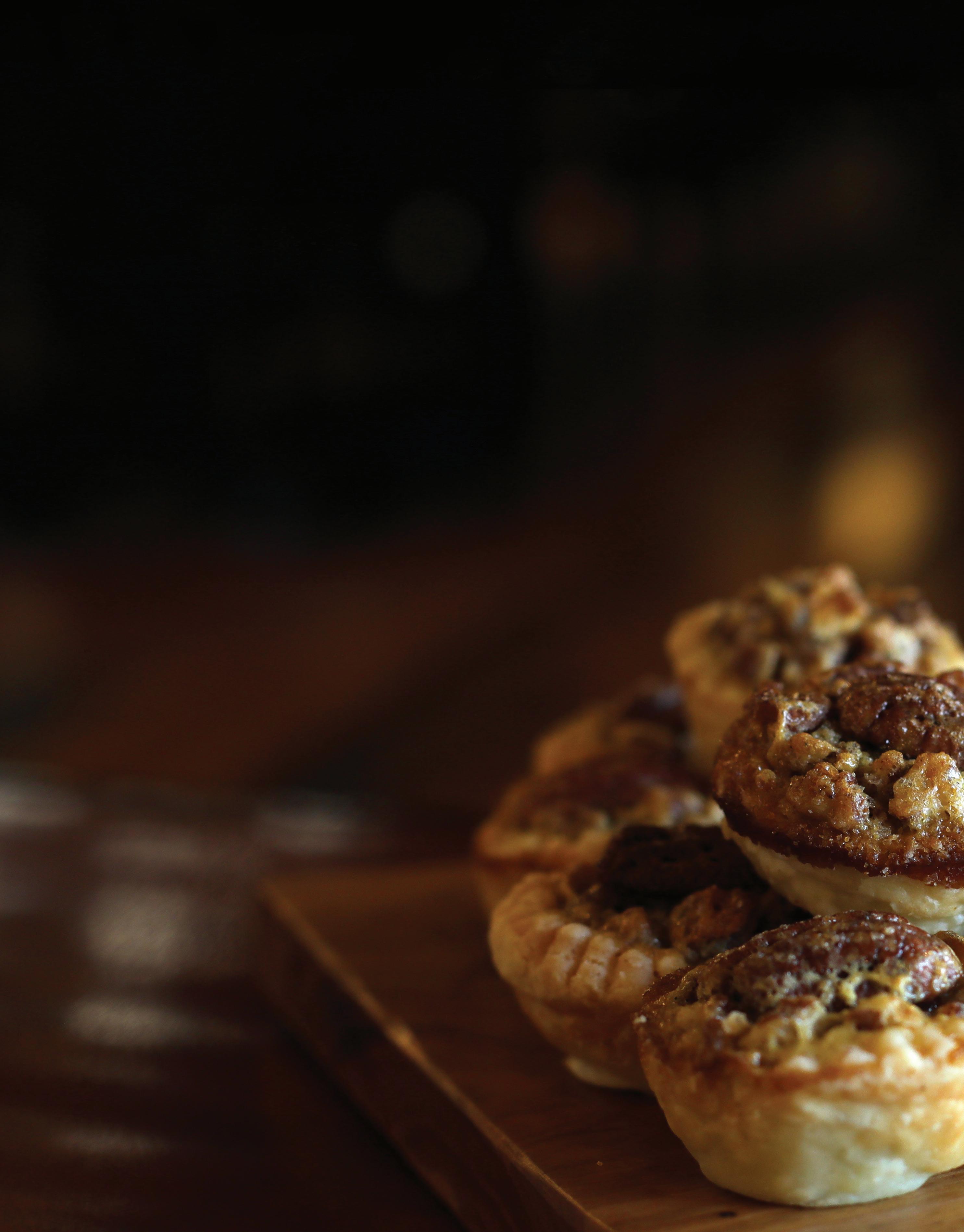
MAKES: about 2 dozen INGREDIENTS
Cream cheese pastry (recipe follows)
2 eggs
½ cup granulated sugar
½ cup karo light or dark corn syrup
2 tbsp bourbon
1 tbsp Mazola margarine, melted and room temp (or unsalted butter)
½ tsp vanilla 1 cup chopped pecans
Confectioners sugar (optional)
PREPARATION
Preheat oven to 350F Bake mode if doing one pan of tassies or 325F Convection mode if doing more than one pan. Spray 1 ¾” muffin pan with nonstick cooking spray. Prepare cream cheese pastry. Divide dough in half. On a floured surface, roll out one half to ” thickness. Cut into 12 rounds, 2 ¼” each. Press into muffin cups making sure to come up the sides of each cup. Repeat with remaining pastry then refrigerate the pan.
In a medium bowl beat eggs. Stir in granulated sugar, corn syrup, bourbon, margarine or butter and vanilla until well blended. Remove muffin tins from the fridge and spoon 1 heaping teaspoon of pecans into the bottom of each cup. Top with 1 tbsp corn syrup mixture. Bake for 20-25 minutes or Convection 18-20 minutes or until lightly browned and a toothpick inserted into the center comes out clean. Cool in pans for 5 minutes then remove and cool completely on a wire rack. If desired, sprinkle cooled tarts with confectioners sugar.
*can be made in Wolf Convection Steam Oven at 325F Convection Humid mode and bake for 1820 minutes or until golden brown.
Chef Brandie and her late grandmother having fun in the kitchen. "My mom and grandma and I would make these delicious little mini pecan tarts every year for the holidays."

CREAM CHEESE PASTRY DOUGH INGREDIENTS
6 tbsp unsalted butter, cold, cut into cubes
1 cup + 1 tbsp all-purpose flour
1/8 tsp kosher salt
1/8 tsp baking powder
1/4 cup cream cheese, cold, cut into cubes
1 tbsp ice water
1 ½ tsp cider vinegar
PREPARATION
Add flour, salt, baking powder to a food processor and pulse to combine. Add in cold cream cheese cubes and pulse a few times. Do the same adding in butter. Add ice water and apple cider vinegar while pulsing the dough. Pulse just enough to combine them, remove and knead on a floured surface. Use the palm of your hand to push out and knead to create flaky layers. Form into disk, plastic wrap and refrigerate for at least 30 minutes while you make the filling
* can double recipe and freeze for later use in pot pies or desserts

Q & A
with Chef Brandie: Wolf Gourmet Mode
Chef Brandie Lamb regularly provides use and care consultations and demonstrations for customers who buy Wolf ranges and ovens. One of the questions she is asked most often is what Wolf Gourmet Mode can offer a home chef.
Q: What is Wolf Gourmet Mode?
Chef Brandie: The Wolf Ovens offer Wolf Gourmet Modes. These modes are preset, chef-driven, step-bystep directions for the customer to use when preparing any dish.
Q: How does it work?
Chef Brandie: Sometimes, it can be tricky deciding whether to choose bake, roast, convection roast, convection, or choice of high, medium, or low broil, so the Wolf Gourmet Mode does this for you! You tell the oven what you are preparing by choosing from a list of preset options, and it guides you through the mode, temperature, and rack placement. Not only does this take the guesswork out of how to get the perfect result, but it also allows the consumer to become familiar with how the different modes or heat distribution work.
Q: Which is your favorite mode to use to prepare a popular dish?
Chef Brandie: My favorite dish to prepare using the Wolf Gourmet Mode is any baked item, especially around the holidays. Whether it is cookies, cakes, muffins, or freshly baked bread, the Wolf oven chooses the best cooking mode for the best result. It’s like having a chef in your kitchen to guide you!
75ISSUE 1 | THE LIVING KITCHEN
baker’s choice
"Using the Wolf Proof Mode provides an advantage to the home baker,” says Patrick McCormick, sous chef at The Barn at Harvest Haven Farm, Sub-Zero, Wolf and Cove’s demo kitchen and gardens in Fitchburg, Wisconsin. “You can be confident that your breads and other yeasted bakes are in the ideal range of temperatures for bulk fermentation and final proofing.”

tional Park.
Tecesequam a senis quiEse sin rem est, quiam, tent vel maximil idestis eossima ximus, ma dolorum quo

77ISSUE 2 | THE LIVING KITCHEN
Wolf's Proof Mode takes the guesswork out of preparing bread dough.
Vite voluptas aut ut reprerum voloriam ad magnis re esequae cturers m voloriam eles
Delicious and easy to make, these buns are perfect for burgers.
McCormick, who is in his fifth year with Sub-Zero, Wolf, and Cove, notes that Proof Mode’s stable environment is especially useful in regions that can experience extreme swings in weather. “The mode is extremely easy to use,” he says. “You just select Proof Mode out of the More category, set your desired temperature, press start, and you’re all set.”
A skilled baker, McCormick has found that Proof Mode supports every kind of bread making. “If doing a straight sourdough, for example, I like to use the Proof Mode at 85° degrees F for the bulk fermentation to keep the dough in a stable environment,” he says. “Typically, I retard those loaves in a Sub-Zero overnight to allow for more flavor to develop. In the morning, I will take the chill off the loaves using the Proof Mode once again while preheating a second oven for the bake.”

Bringing over fifteen years of restaurant experience to his role at Sub-Zero, Wolf and Cove, McCormick is responsible for the day-to-day operations of the kitchen at The Barn at Harvest Haven Farm. His responsibilities range from menu and recipe development and ordering and organizing product for events to leading front-of-house and back-ofhouse teams during trainings and events. “I also support Corporate Chef Joel Chesebro with demonstrations,” he says, “and help him with our amazing Chef Network Community.”
McCormick has an extensive collection of tried-andtrue bread recipes, including Potato Hamburger Buns, which he shares with the readers of The Living Kitchen
“This is one of my favorite recipes for potato buns, which are great for burgers,” he says. “It is quick, easy, and uses Wolf’s Proof Mode.”

78 THE LIVING KITCHEN | ISSUE 2
MAKES: 9 buns
Potato Burger Buns
At abo. Nam enditis estrunt quos audis eum aliquati o.
PREPARATION METHOD
1. Add all dough ingredients to the bowl of a stand mixer. Mix on low speed for 10 minutes until smooth, pliable dough has formed.
c
Purpose Flour
potato flour
dry milk powder
Fondue
sugar
kosher salt
dough to greased mixing bowl. Place the bowl inside bun bag or wrap with plastic wrap.
bowl in the oven with rack at position 1, set 85 ℉ in proof mode, which is found in the more menu. Proof for 35 minutes
until doubled
PREPARATION METHOD
volume.
Make this dessert your own—experiment with different semisweet and bittersweet chocolates.
instant yeast
butter, softened
water, warm
MAKES
SERVINGS
Wash: (Optional)
heavily beaten
INGREDIENTS
milk or water
semisweet or
milk
heavy cream
teaspoons vanilla extract
fruit, pound cake, and
TIME
MINUTES
Using the scale, weigh the dough into separate 3 oz. pieces. To shape the dough pieces drag them one at a time in a circular motion on the countertop to eventually shape a tight ball. Gently press into a disc about 4 in. wide. Place onto a sheet tray that has been lined with nonstick sprayed parchment paper.
Once all of the dough pieces are shaped, place tray inside bun bag or wrap with plastic and return to oven still set to proof mode, let buns rise for 30 minutes or until doubled.
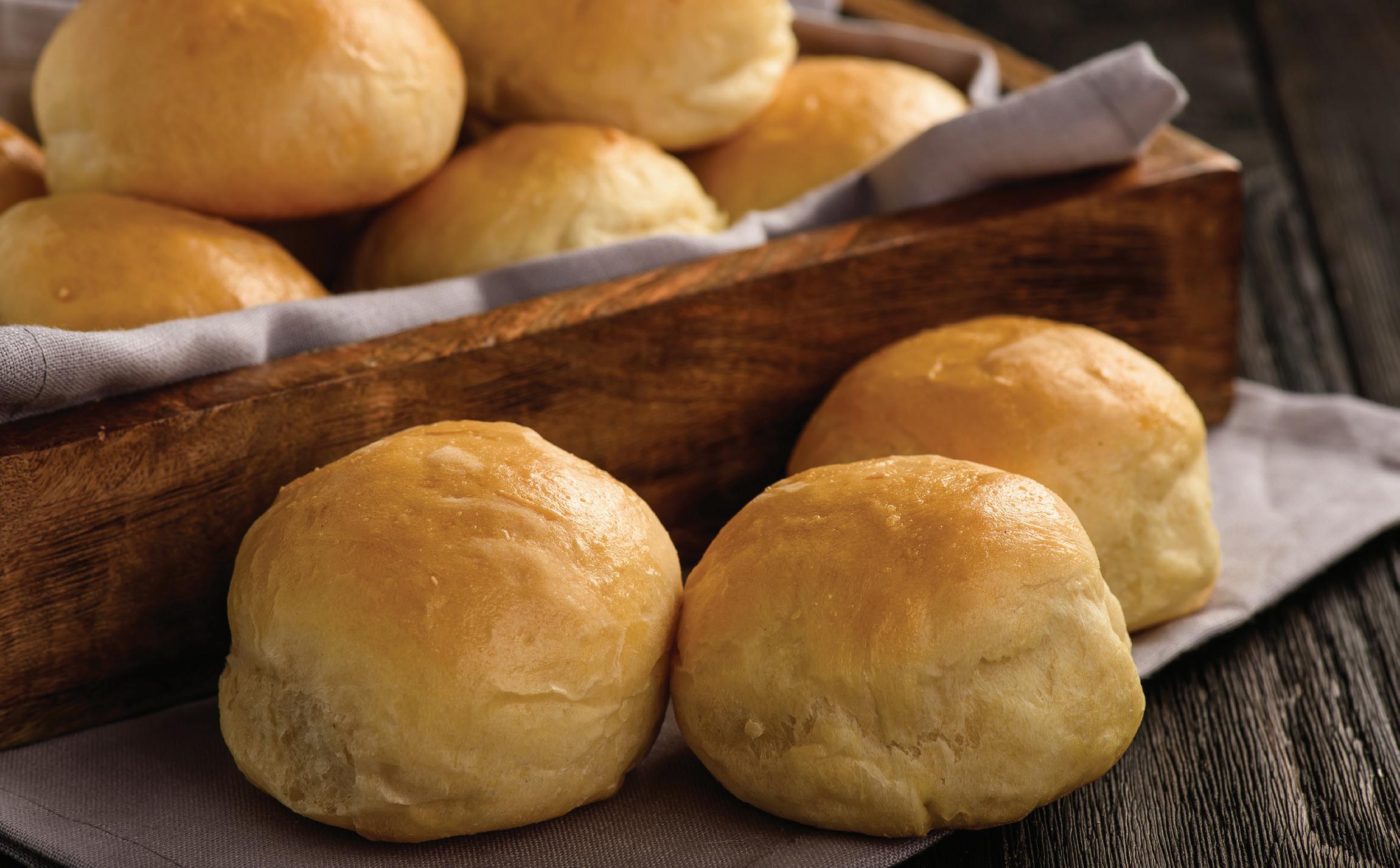
chopped
for dipping
When buns have doubled in size removed from oven. Preheat oven to 350 ℉ convection. Once preheated remove bag/plastic wrap from tray, and gently brush buns with egg wash if using.
Place the tray into the oven. Bake for 17 minutes.
the buns
1. In a medium saucepan, combine chocolate, milk, and cream. Heat on low, stirring often, until the chocolate is completely melted and the mixture is smooth. Keep the heat low to prevent the mixture from coming to a boil. 2. Once melted, add the vanilla extract. 3. Turn the burner to the lowest setting to hold the melted chocolate at the perfect serving temperature. Stir in an additional tablespoon of cream for a thinner consistency, if desired. Serve alongside fresh fruit, pound cake, and cookies.
for 15 minutes before serving.
79ISSUE 2 | THE LIVING KITCHEN
2 cups
bittersweet chocolate,
1/2 cup
1/2 cup
1½
Fresh
cookies,
COOK
8
15
INGREDIENTS Dough: 2 and 3/4
All
1/3 c
1/4 c
1/8 c
1 and 1/4 tsp
2 tsp
1/4 c
3/4 c
Egg
1 egg,
1/4 C
2. Transfer
3. Place
or
in
4.
5.
6.
7.
8. Let
sit
Quiatem.
ART BOARDthe of
Curate the perfect charcuterie board with tips and tricks from the experts at Lazy Suzen.

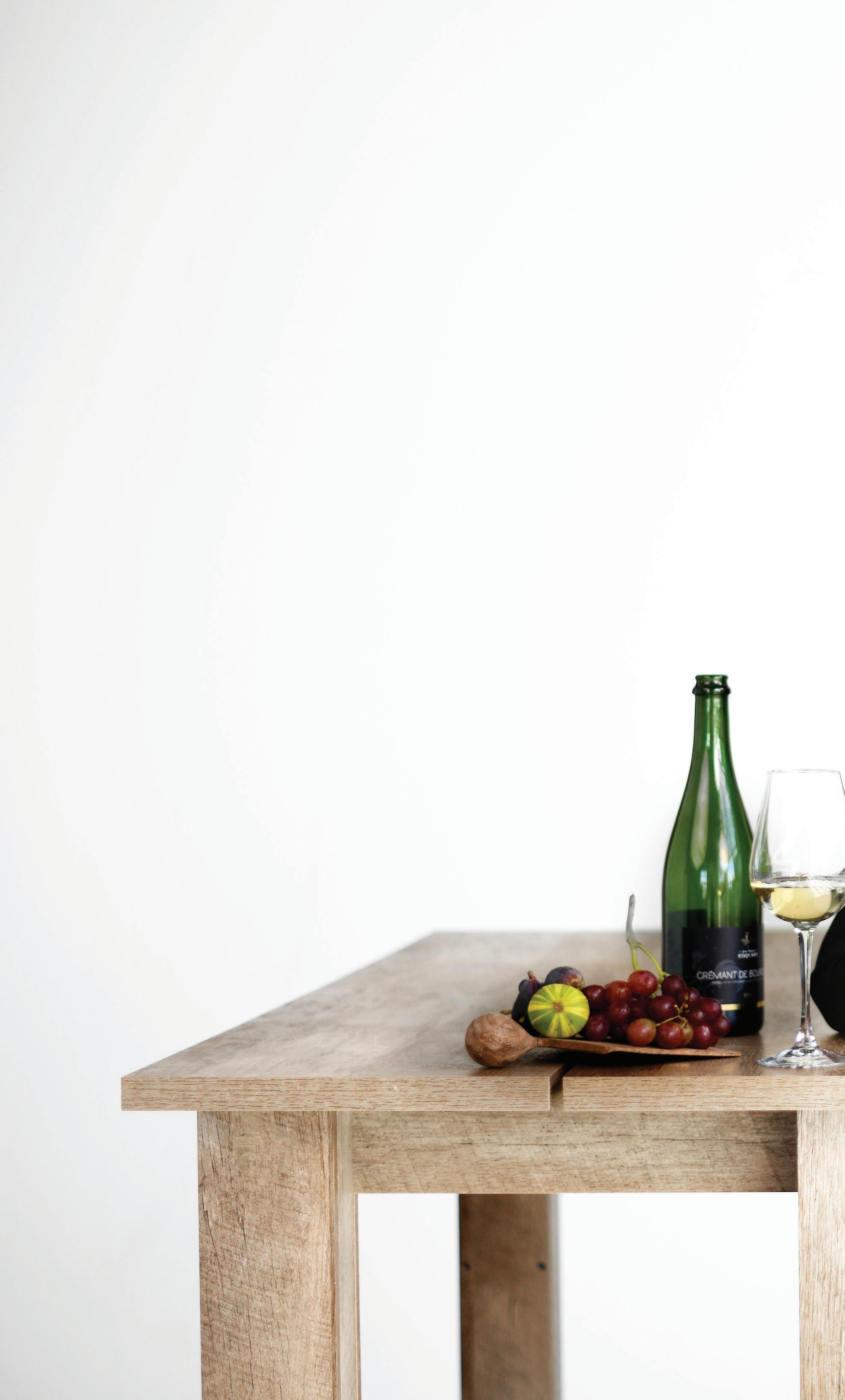
A few years ago, sales professional Erin Tomlinson was on vacation when she enjoyed what she calls an “amazing charcuterie spread.” She texted her good friend Tiffany Golden, who has a background in florals, with a bold suggestion: To start a bespoke charcuterie business in their hometown of Madison, Wisconsin. “We wanted to work together but we had no idea what that would exactly look like,” says Tomlinson. “Lazy Suzen was serendipitous.”
Today, the two are increasingly busy providing their carefully crafted boards and boxes - even clever charcuterie ‘cones’ - to Madison homes and businesses. We asked them to give the readers of The Living Kitchen a quick lesson on how to assemble a charcuterie board that is dressed to impress.
Tasty pastries and savory accents complete this delectable Breakfast Board.
 Photography by Marla Bergh
Photography by Marla Bergh
“ WE ARE ALWAYS ON THE HUNT TO FIND FUN LOCAL AND DIFFERENT OPTIONS TO ADD.”
Dinner is served with this charcuterie board brimming with cheeses, meats, olives, and unique fruits.

START WITH THE PLATFORM:
They suggest experimenting with wooden cutting boards or interesting-shaped platters and, for large grazing tables, incorporating three different elements such as metal, wood, and pottery. Their one hard and fast rule is that a Brie wheel will always be placed on a round pedestal. “Other than that, we live on the edge!” says Tomlinson
ADD VESSELS:
Next, place the smaller bowls and cups, so you can begin to fill in edibles around them. Pedestals can offer different heights or dimensions elements to a display. “We love little wooden, bamboo, or white ceramic bowls to house our honey or jams.”
ON TO CHEESE:
The Lazy Suzen ladies recommend using triangles, cubes, or small broken-up bits of between two to four artisan cheeses. Vary the textures and flavor profiles of the cheeses. Pick your favorites but try something new too!
MEET THE MEAT:
After the cheese is placed, move on to the sliced meats. They like to add curves with a ‘shaped river’ running through the board. “We always use prosciutto it makes the best ribbons,” says Tomlinson. “We also use Genoa salami makes the best rivers and roses, and Capicola can make real luscious flowers.”
EAT YOUR VEGGIES:
Tomlinson recommends heading to your grocery store or farmers market to get inspiration. “Anything colorful that catches your eye when you shop will look great on your board!” Daikon radishes are gorgeous on a spread, broccolini is a great green addition, and rainbow-colored carrots are fun. “Using a mandolin on a cucumber can give you a whimsical ribbon, she says. “You can slice pea pod, leaving the peas on one side, for a stunning addition.” Artichokes add texture, sliced peppers are great, and purple cauliflower is a lovely, unexpected touch.
82 THE LIVING KITCHEN | ISSUE 1
FRUIT FORWARD:
Take advantage of fresh seasonal fruit like whole blackberries, raspberries, cherries, halved strawberries, and sliced apricots, apples, pears, or peaches. With grapes, smaller bunches are the easiest to grab. Dried fruits, nuts, and olives can round out the board anytime time of year. “We love using unexpected dried fruits such as blood oranges, pineapple slices, Meyer lemons, and cute little key limes.”
BREADBASKET:
“We are always on the hunt to find fun local and different options to add,” says Tomlinson. Some ideas: sliced garlic baguette, fig and olive crackers, rice crackers, and breadsticks, which add height.
COMPLEMENTARY CONDIMENTS:
“Honey is a MUST!” says Tomlinson, who also likes to add jams such as fig, strawberry, or blackberry. Savory options include mustards, tapenade, and dips.
FINAL FLOURISH:
Use fresh herbs, such as rosemary, thyme, oregano, mint, and pineapple sage, as a tasty garnish. Recently, Lazy Suzen has added chamomile blossoms to their lineup, and they also suggest adding non-edible greenery, such as eucalyptus, for a pop of color on larger spreads. A sweet closing note could be sprinkle-dipped marshmallows or chocolatecovered pretzels.
KEEPING IT FRESH:
Party prep: If you are serving your board the next day, it’s totally doable to create the board ahead of time and refrigerate it overnight. Sub-Zero’s precision humidity control will keep your creation pristine. The other option is to cut all your cheeses in your desired shapes, fold all the cured meats and have all the fruit washed and dried. Store them in the refrigerator and assemble everything shortly before your event starts. You won’t have to worry with SubZero ~ everything will be deliciously fresh for your guests!
Leave room for dessert! This sweetly laden board has a delightful mix of cookies, cakes, and seasonal fruits.
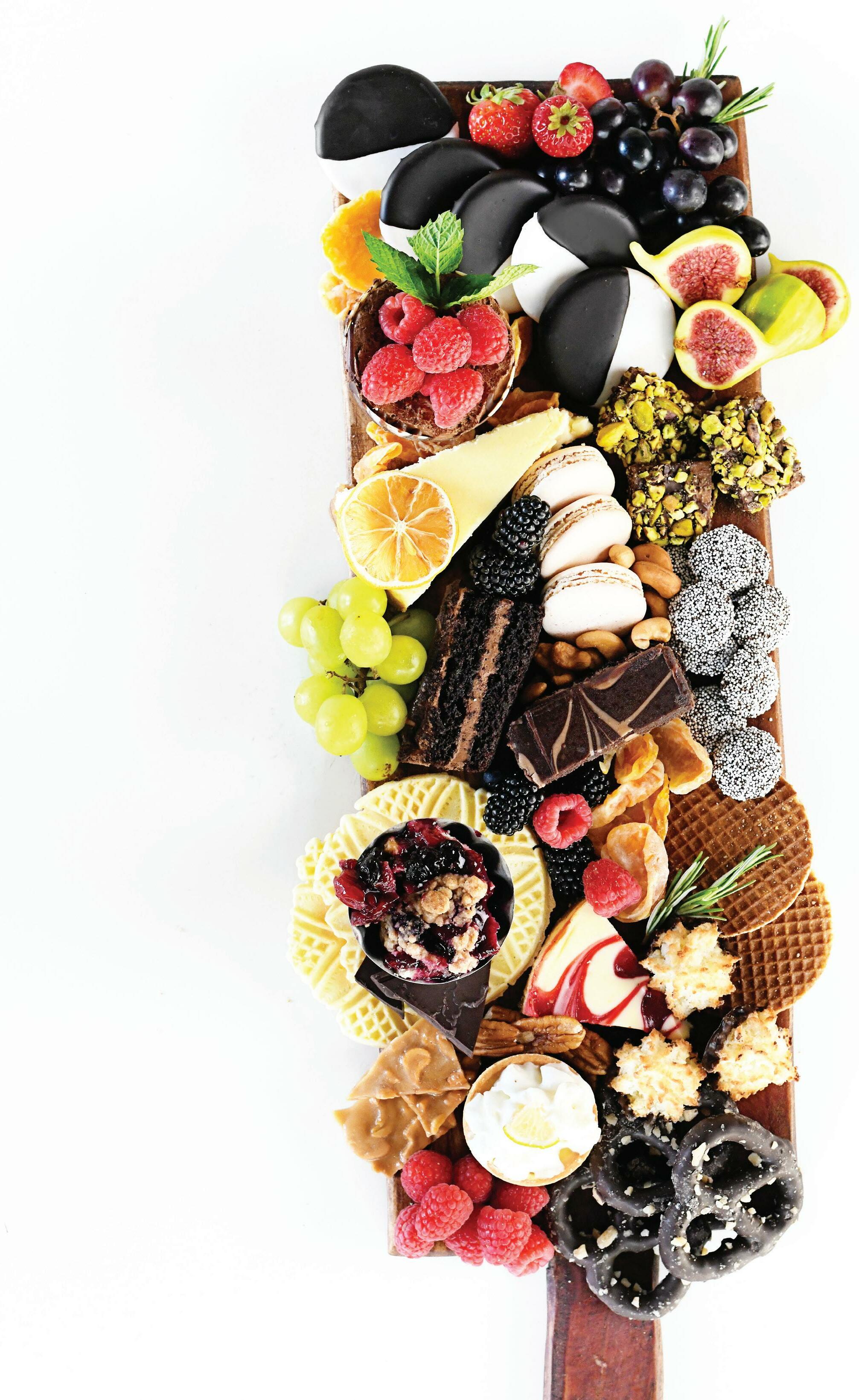
Healthy Healing
DELICIOUS AND VERSATILE HERBS, THE LEAFY PART OF A PLANT, AND SPICES, WHICH TYPICALLY COME FROM THE SEED, CAN OFFER REMARKABLE HEALTH AND WELLNESS BENEFITS.
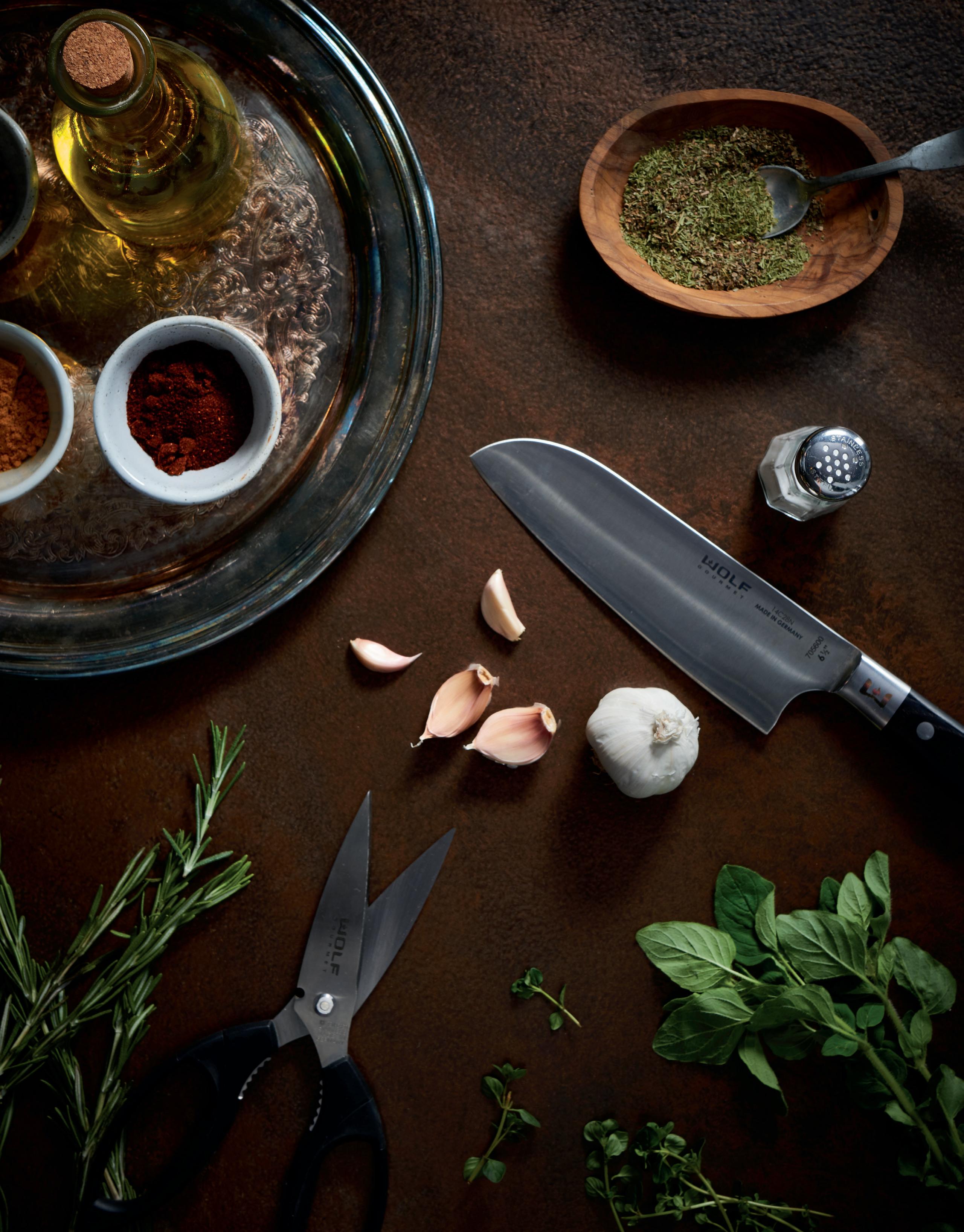
Here are seven nature-made ingredients that you can use in teas, infusions, and other simple recipes to help boost your health:
Cinnamon can lower blood sugar levels and triglycerides.
Tumeric is a potent anti-inflammatory due to its active ingredient, curcumin.
Studies have shown that the antioxidants in Garlic can help protect against cell damage and aging.
Aid digestion, alleviate nausea, and soothe an upset stomach with Ginger
Rosemary is a rich source of antioxidants and anti-inflammatory compounds, which can help boost immunity, improve blood circulation and lessen nasal congestion.
Mint is another tasty herb that is great for indigestion and IBS pain and also helps lessen nasal congestion.
Capsaicin is the main bioactive plant compound in Chili Peppers. This powerful element helps fight fungal infections, colds, and the flu and relieves joint pain.
(Always consult your doctor for advice about natural supplements.)
Mulled Cider
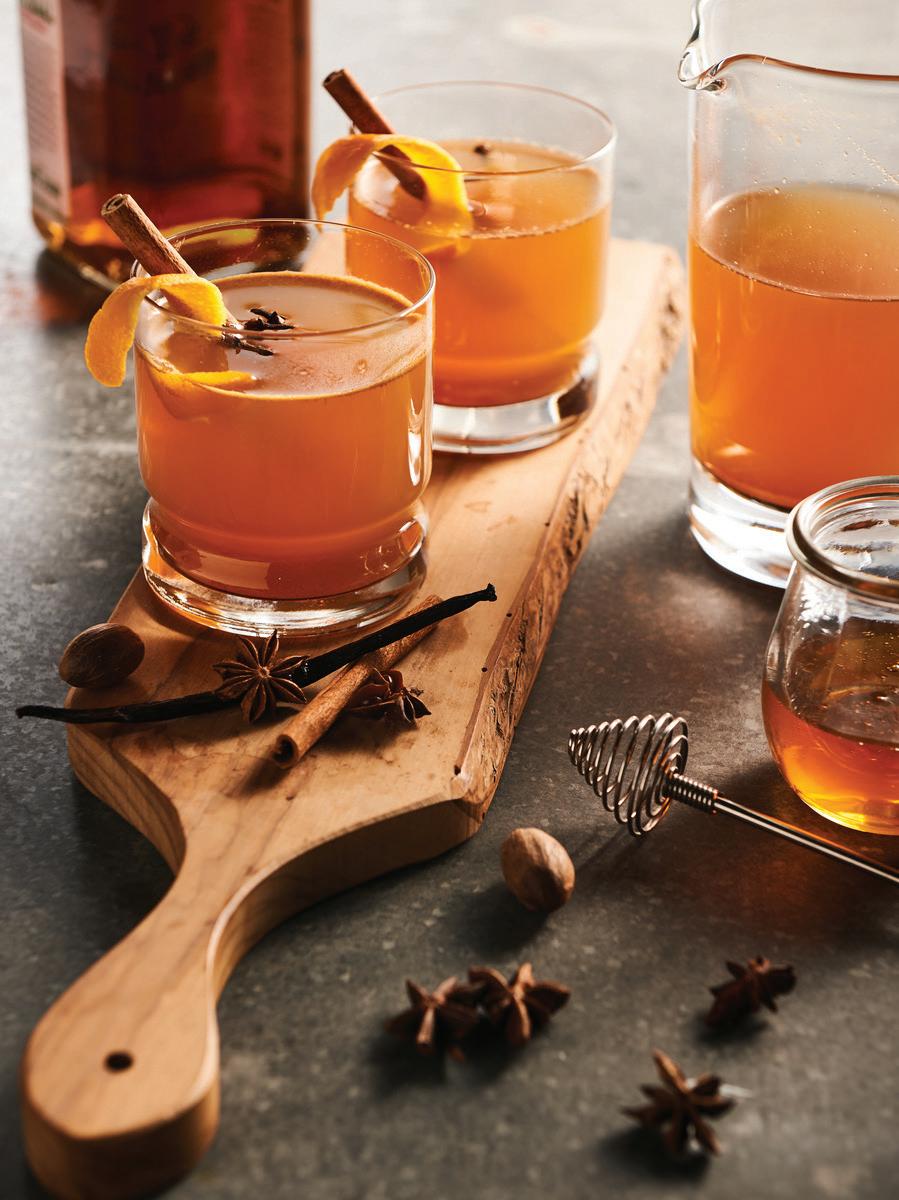
INGREDIENTS
cups apple cider, cold
of one orange, all white pith
cup brandy or bourbon, or a mixture of both (optional)
cup honey
tablespoons pure maple syrup
piece peeled ginger root, sliced into planks
whole allspice berries
whole cloves
cinnamon stick
star anise pod
teaspoon freshly grated nutmeg
vanilla bean, split lengthwise
PREPARATION METHOD
In a medium-sized bowl, whisk together all the ingredients until the honey and maple syrup are fully dissolved.
Pour the contents into a large vacuum seal bag
Place the bag into the vacuum seal drawer with the edge of the bag just barely under the metal clip.
Center the bag on the sealing bar to ensure a proper seal. Select vacuum level
Touch Start and set a timer for 30 seconds. If after 30 seconds the unit has not completed its cycle, touch Seal to stop the cycle and seal the bag.
Open the lid and slide the bag the rest of the way under the metal clip. Touch Vacuum until no dashes are illuminated, thus setting vacuum level
Touch Start and the vacuum will run for several seconds to pull the lid closed.
After the cycle is complete, inspect the bag’s seals. There should be two seal lines across the top of the bag.
Heat the bag sous vide for 2 hours at 145°F.
Use the Wolf convection steam oven, separate sous vide equipment, a pot of water with an immersion circulator, or simply a pot of water on the stove and a thermometer.
Cut the bag open and serve hot.
4
Peel
removed 1/2
1/4
2
1-inch
6
5
1
1
1/4
1/2
1.
2.
3.
4.
3. 5.
6.
0. 7.
8.
9.
10.
11.
Infused with enough cheer to last the year.
Pea Soup with Mint Oil
Don’t skip the mint oil for this fresh soup; it adds an additional layer of complexity.
MAKES: 4 servings
INGREDIENTS
Mint Oil
1 cup grapeseed, canola, or other neutral oil
1 cup loosely packed fresh mint sprigs
Spring Pea Soup
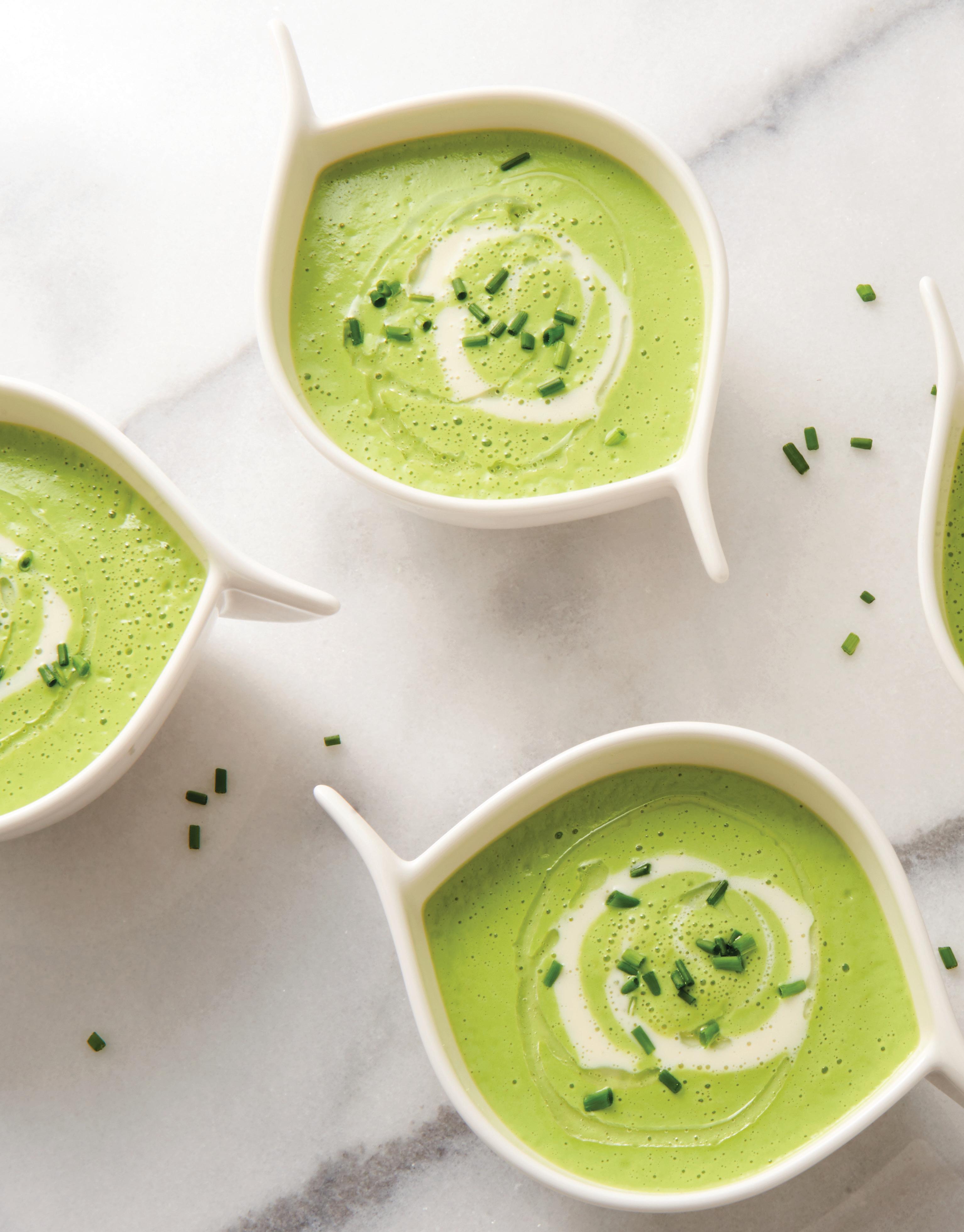
2 tablespoons butter
2 medium leeks, white and light green parts only, trimmed, cleaned, and cut in thin slices
2 cloves garlic, roughly chopped
1 teaspoon kosher salt, divided
2 cups chicken broth
16 ounces fresh, shelled peas (or frozen peas, defrosted)
¼ cup fresh mint leaves
½ cup half and half
¼ cup plain Greek yogurt
¼ teaspoon freshly ground black pepper
2 teaspoons freshly squeezed lemon juice
Toppings
Crème fraiche, for serving
Chives, chopped, for serving
PREPARATION METHOD
Make the mint oil
1. In a small saucepan over medium, heat the oil.
2. Break up the mint sprigs and add to the saucepan.
3. Heat until mint is fragrant, 10 to 15 minutes.
4. Remove from heat and strain the mint leaves.
5. Transfer oil to a squeeze bottle.
Make the soup
6. In a large skillet over medium heat, melt the butter.
7. When butter is bubbling, add leeks, garlic, and 1/4 teaspoon salt.
8. Cook until leeks and garlic have softened, 10 to 12 minutes.
9. Add remaining soup ingredients except for lemon juice to the blender in the order listed.
10. Add leek and garlic mixture.
11. Select the SOUP setting and press start.
12. Once the cycle finishes, add lemon juice and PULSE several times to combine.
13. Divide the soup among bowls.
14. Top with a dollop of crème fraiche, drizzle with mint oil, sprinkle with chopped chives, and serve.

 Elizabeth Wohlers relishes working with other engineers and designers in the L.C. Bud Bakke Innovation Center.
future- FOCUSED
Elizabeth Wohlers relishes working with other engineers and designers in the L.C. Bud Bakke Innovation Center.
future- FOCUSED
Engineer Elizabeth Wohlers is breaking new ground in Advanced Product Development at Sub-Zero.
BY LISA CAVANAUGH
orking from the Ad vanced Product Devel opment lab in the L.C. Bud Bakke Innovation Center, Sub-Zero Staff Engineer Elizabeth Wohlers spends her days thinking about condensation. And airflow. And temperature set points. Her passionate focus has resulted in two U.S. patents, one for a shared evapo rator system and the other for a split airflow system, both of which translate to unparalleled refrigeration performance for Sub-Zero customers.
After graduating from the University of Wiscon sin-Platteville with a degree in mechanical engi neering, the Illinois native went to work right away for Sub-Zero.“ I started there in design engineering as part of the UW’s Cooperative Education Program in 2010, and then got hired full time in New Product Development,” says Wohlers, now a staff engineer in the Advanced Product Development department. “Sub-Zero is a terrific place to work. There is such a great environment here to pursue your ideas and innovations.”
The impetus to solve airflow challenges in refrigeration that led to Wohler’s most recent patent (2022) also came from the marketing department, says Wohlers. The goal was to provide the customer with more temperature control. Wohlers and her
Wteam invented a way to allow one refrigerator to have different temperature set points. The Spilt Airflow System design means the crisper drawers can be controlled independently over the same or different temperature ranges. “This gives the customer more control and more options,” she says, “which is really useful when, for example, you have leafy vegetables that you want to store at the lowest set point in one zone but also squash or peppers that should be stored a few degrees warmer in another zone.”
The invention process included numerous com puter simulations that showed how the air would move. “We wanted to ensure we would get proper cooling in each zone and that we wouldn’t have any warm spots or any kind of temperature deviations that the customer would notice,” says Wohlers. Prior to using simulations, engineers would have had to rely on building a prototype, and if it didn’t work, they’d have to rebuild.With simulation, Wohlers and her team could turn it around in days versus weeks. She goes on to explain that without the company’s investment in the computer model simulations, they would have had to undergo a very iterative prototype process. “It is a huge time saver and gives us a lot of confidence that what we build is going to be a good solution,” she says. “It’s just one of the ways the Sub-Zero company really facilitates innovation.”
91ISSUE 2 | THE LIVING KITCHEN
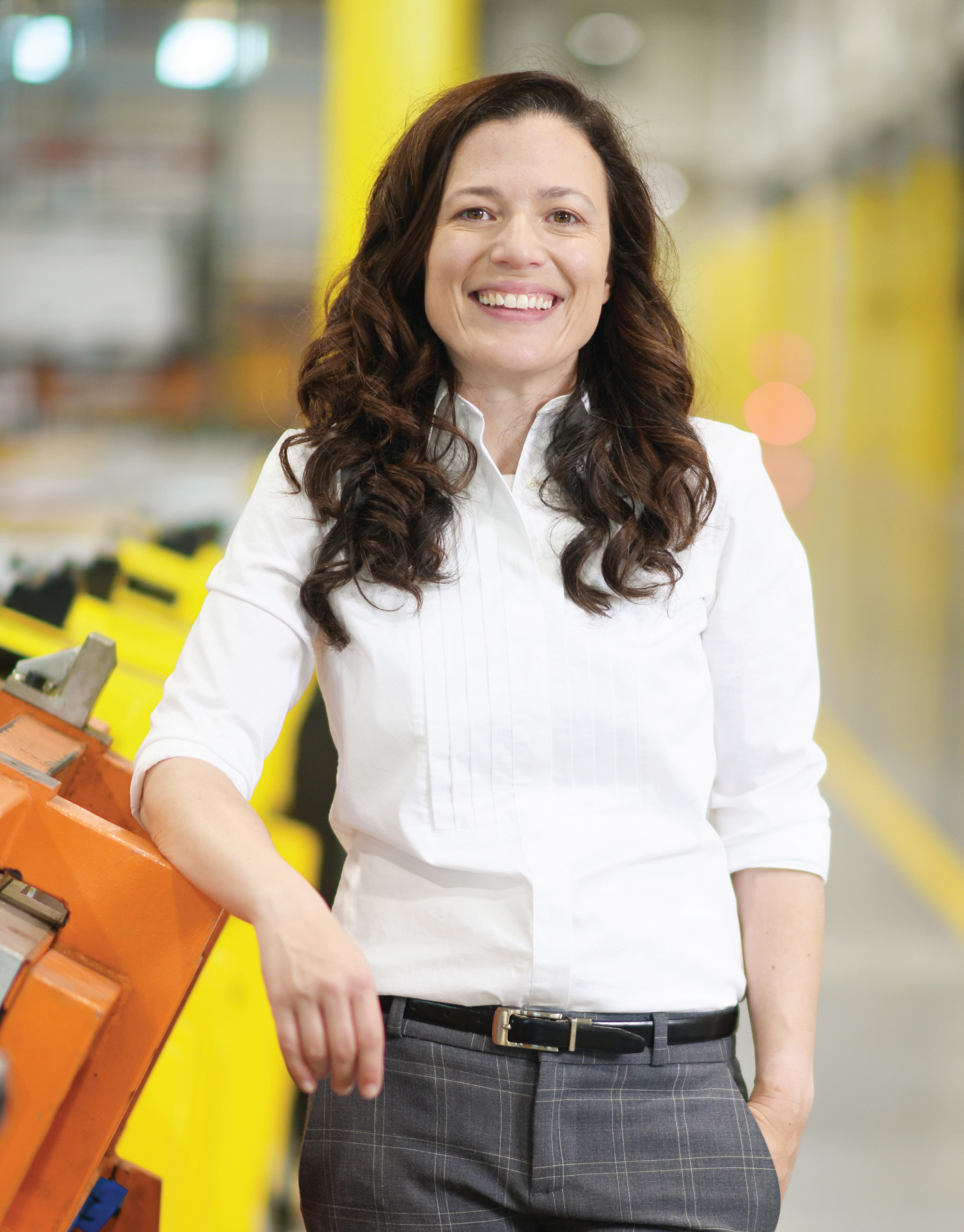
Wohlers received a patent for her work developing Sub-Zero’s Split Climate™ intelligent cooling system.


Being a patent recipient hasn’t changed her day-to-day life, says Wohlers, who lives with her husband, an engineer spe cializing in thermoforming packaging, not far from Sub-Zero’s Madison headquarters. What matters more to her is the team she works with daily. “My name may be on the patents, but there are a lot of people whose hard work went into these processes, “she says. “It is an honor to have the patents, but honestly, it is just so nice to be able to join the ranks of Sub-Zero engineers.”
She also relishes the scientific collaboration that comes with sharing the Innovation Center with so many talented people. “There are designers, engineers, marketing people here, and seeing what other people come up with can spark your own im agination,” says Wohlers. “It’s a really exciting process and defi nitely fun to be a part of.” She also stresses that the end result is a high-quality product for the customer. “It really is an amazing process. So many people are involved in designing and producing a Sub-Zero refrigerator,” she says. “It’s why they last so long and are such superb appliances.”
Ultimately, this focus on quality and innovation is what makes her love working at Sub-Zero as much as she does. “The great thing about this company is that if you have a good idea, they encourage you to run with it,” she says. “It’s really such an amazing opportunity to be an engineer here.”
93ISSUE 2 | THE LIVING KITCHEN
IN THE NEXT ISSUE, The Living Kitchen takes you around the world to spectacular destinations where you can luxuriate in natural healing waters, like the Blue Lagoon in Iceland.

96 THE LIVING KITCHEN | ISSUE 2
FORWARD LOOK



































 By Marni Elyse Katz Photography by Dan Cutrona
By Marni Elyse Katz Photography by Dan Cutrona













 BY JANICE RANDALL ROHLF
BY JANICE RANDALL ROHLF

















































 PHOTO BY GIEVES ANDERSON
Executive Chef Brandie Lamb enjoys creating intriguing seasonal menus, with everything from cocktails to desserts.
PHOTO BY GIEVES ANDERSON
Executive Chef Brandie Lamb enjoys creating intriguing seasonal menus, with everything from cocktails to desserts.













 Photography by Marla Bergh
Photography by Marla Bergh






 Elizabeth Wohlers relishes working with other engineers and designers in the L.C. Bud Bakke Innovation Center.
future- FOCUSED
Elizabeth Wohlers relishes working with other engineers and designers in the L.C. Bud Bakke Innovation Center.
future- FOCUSED



